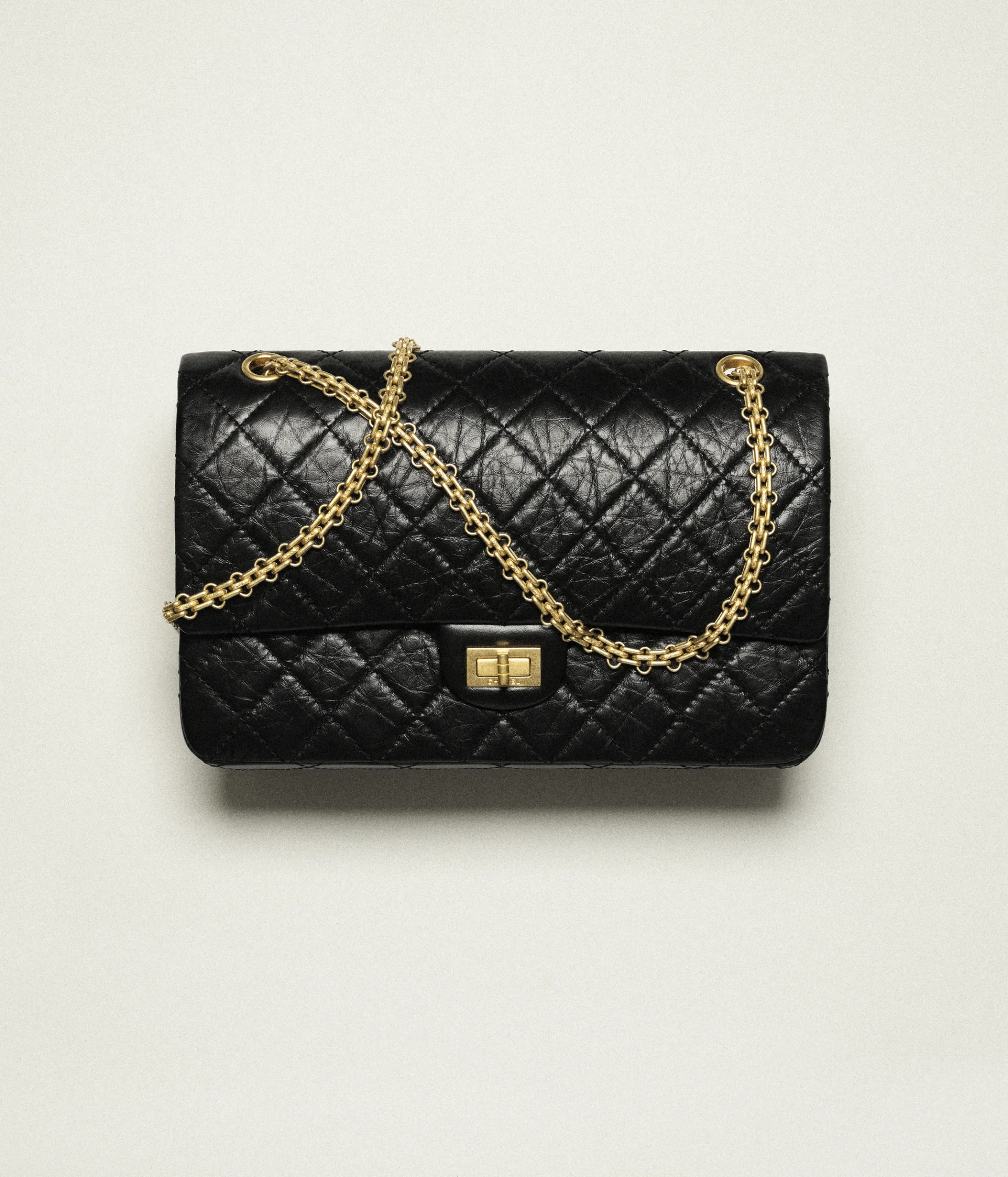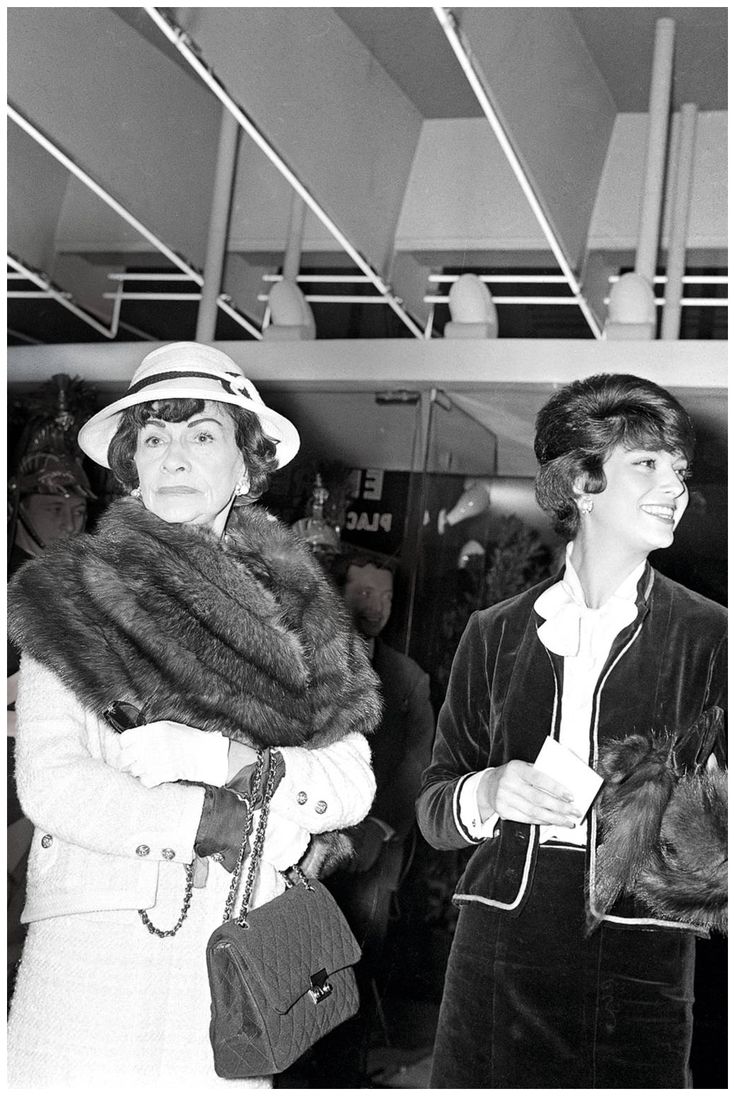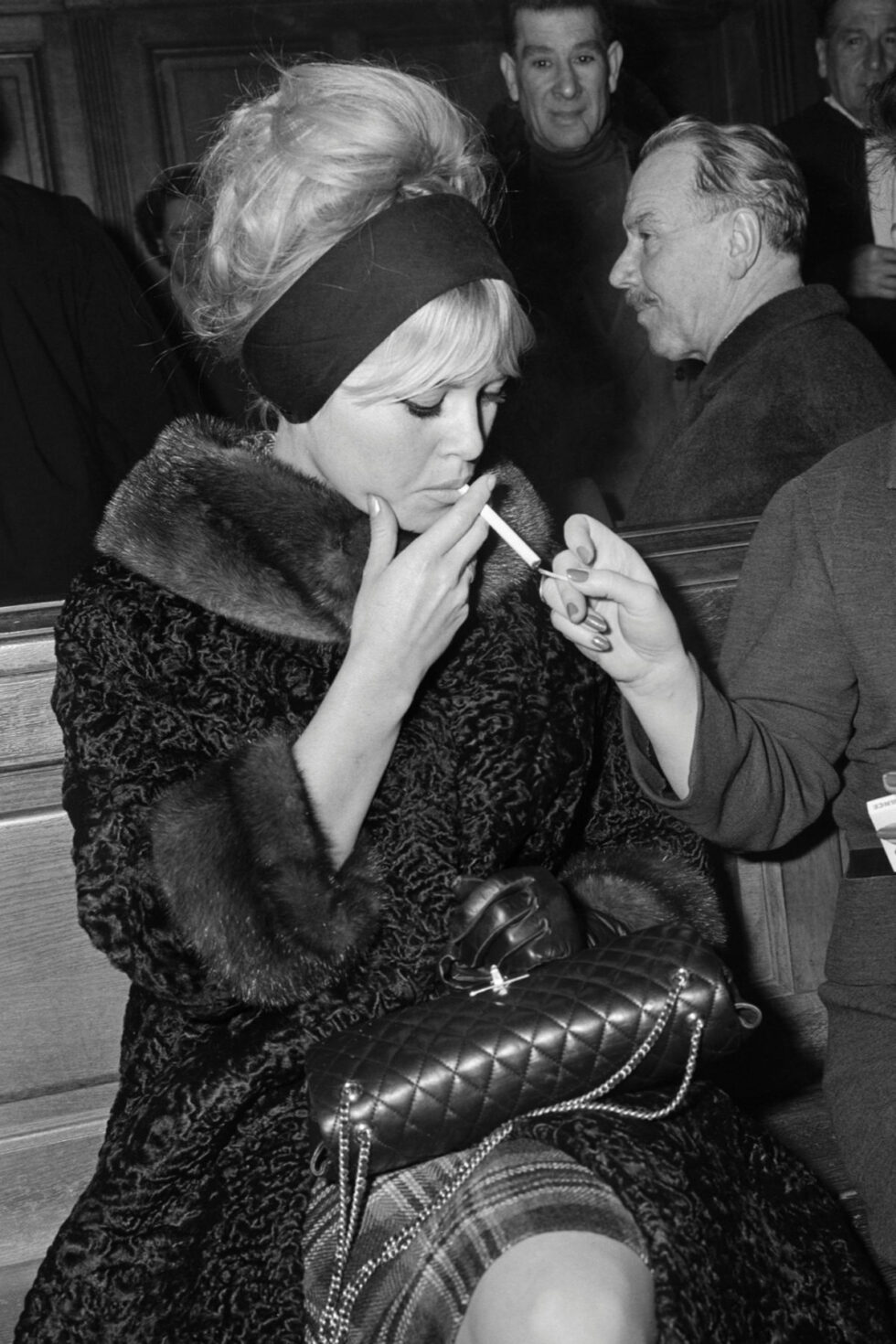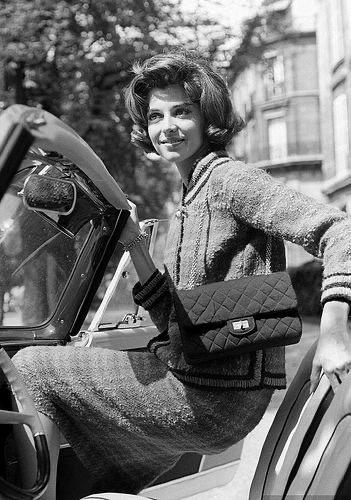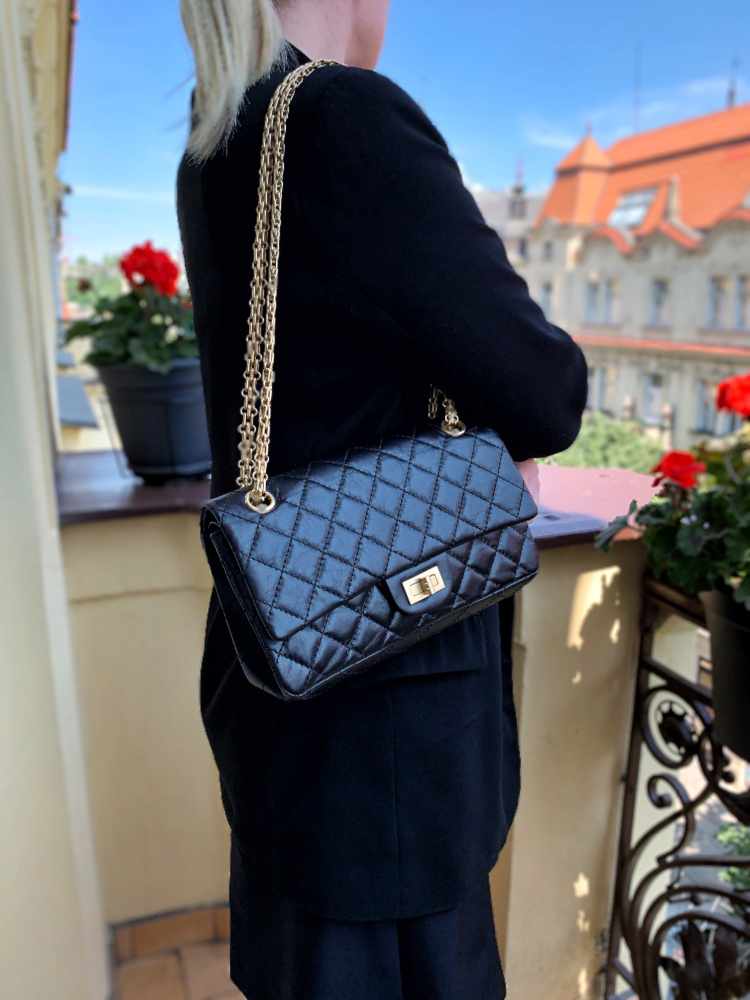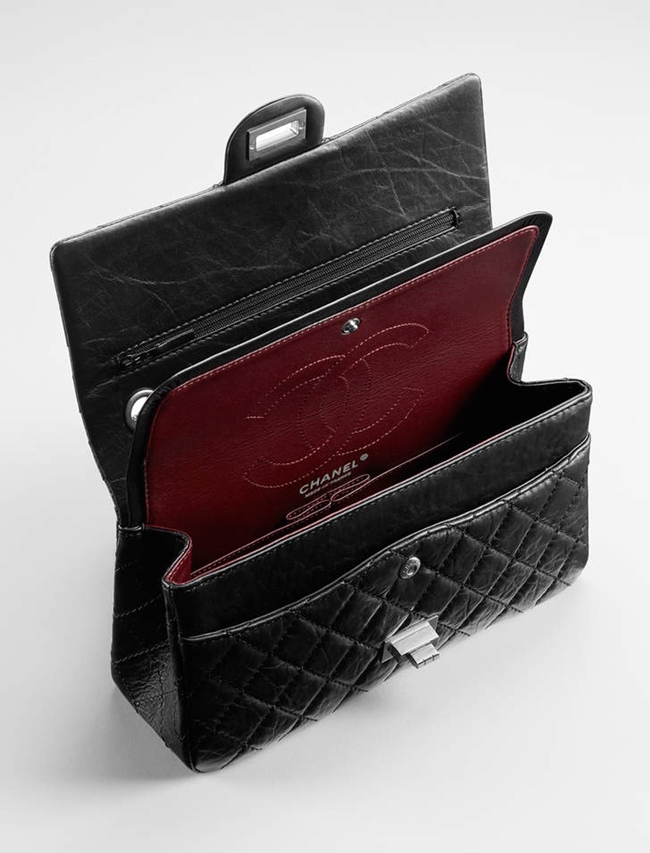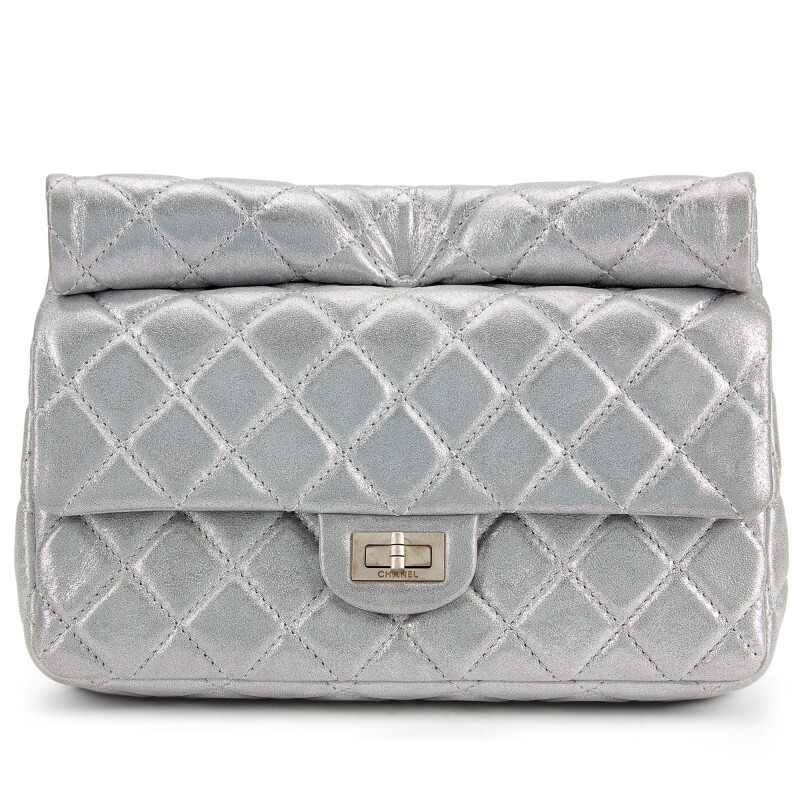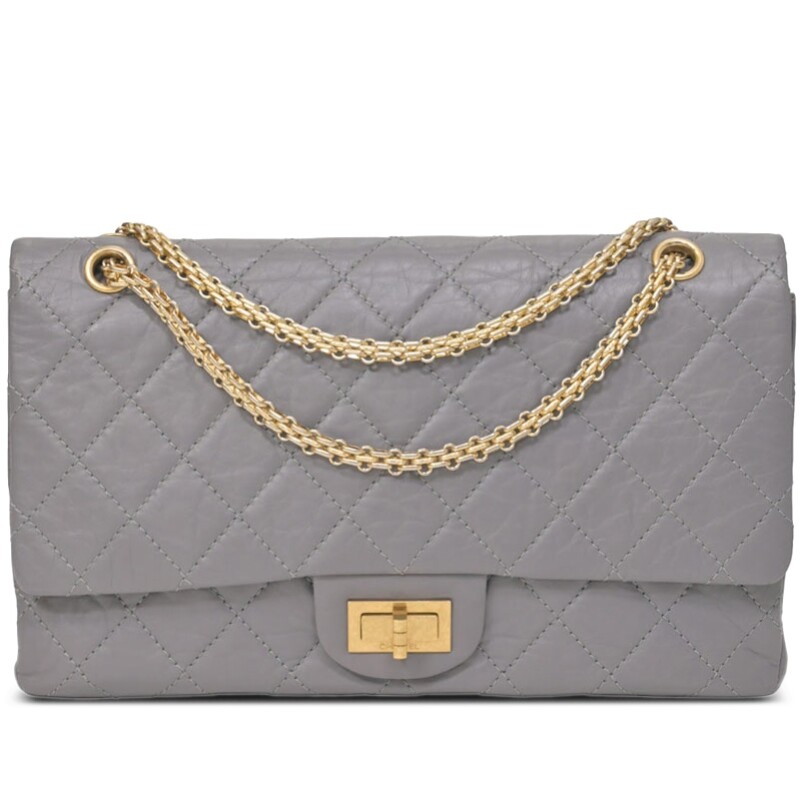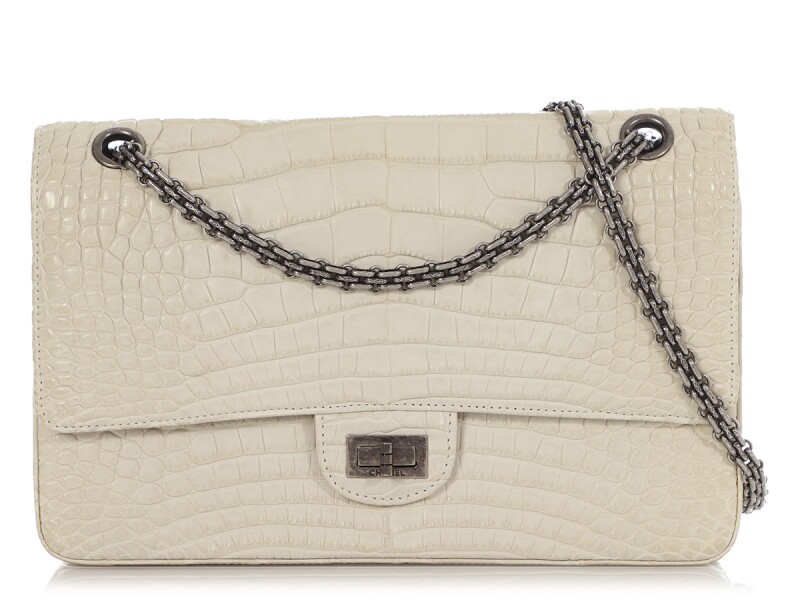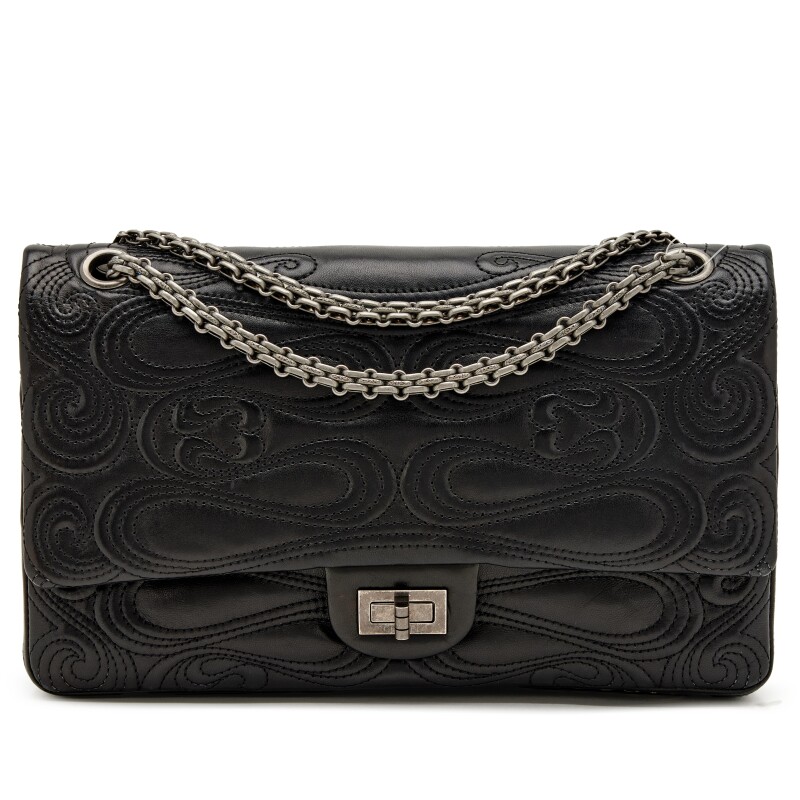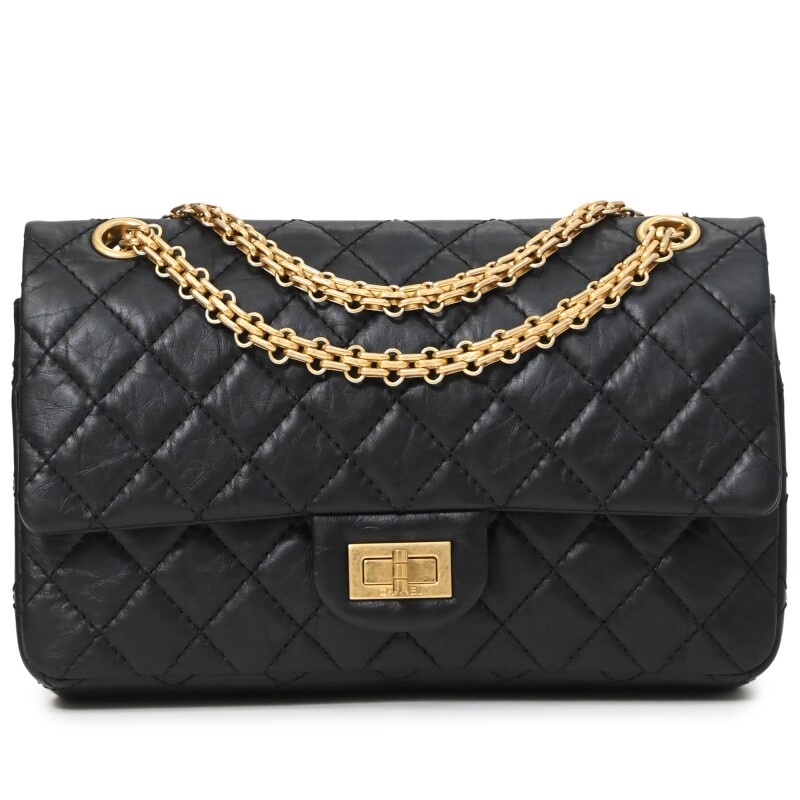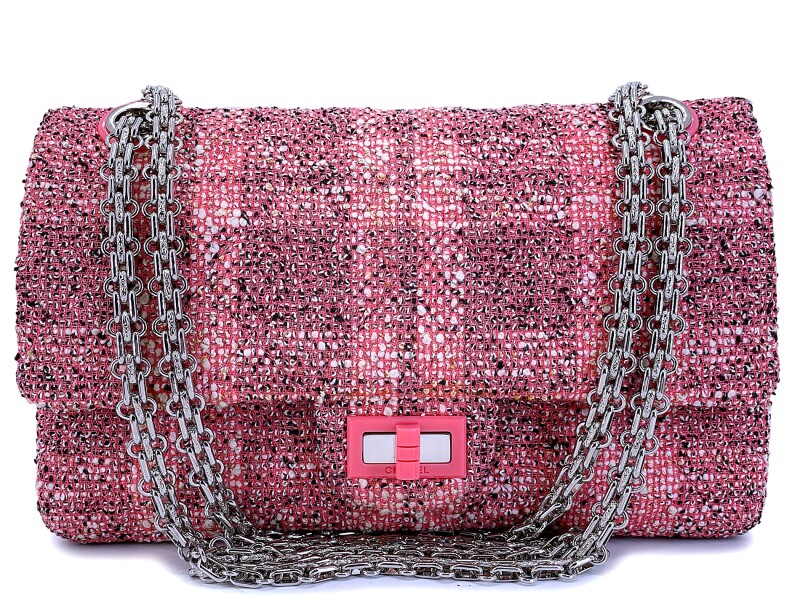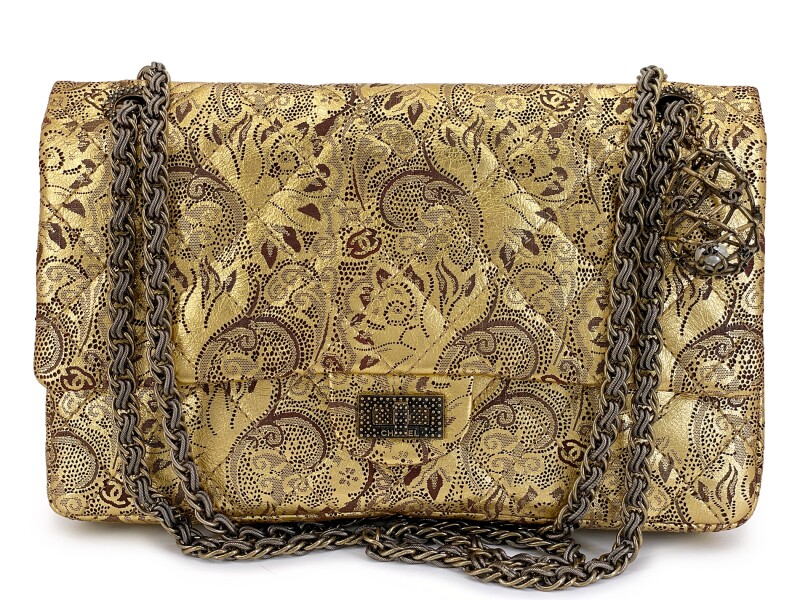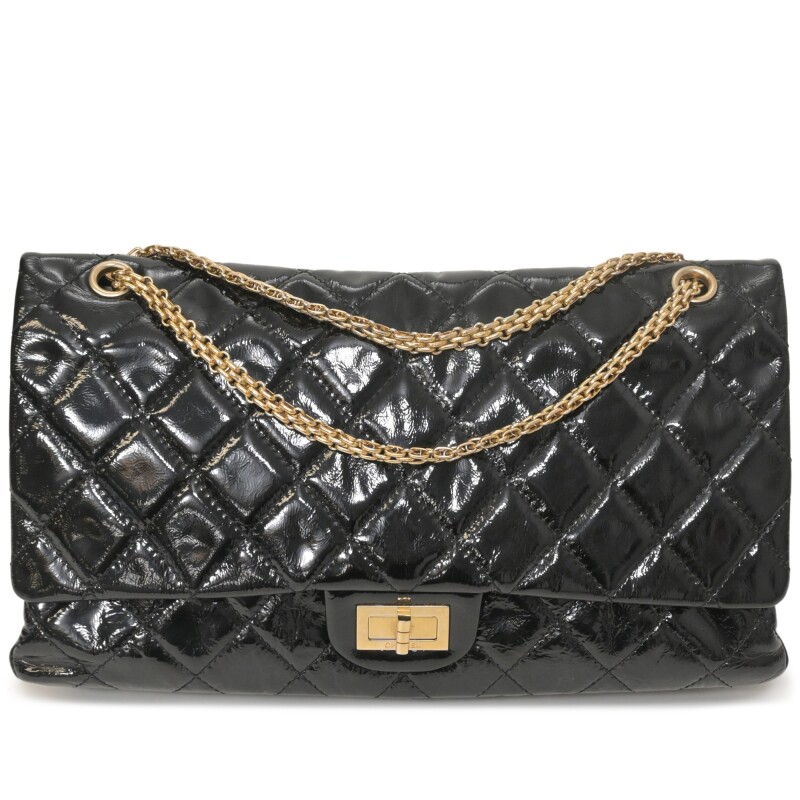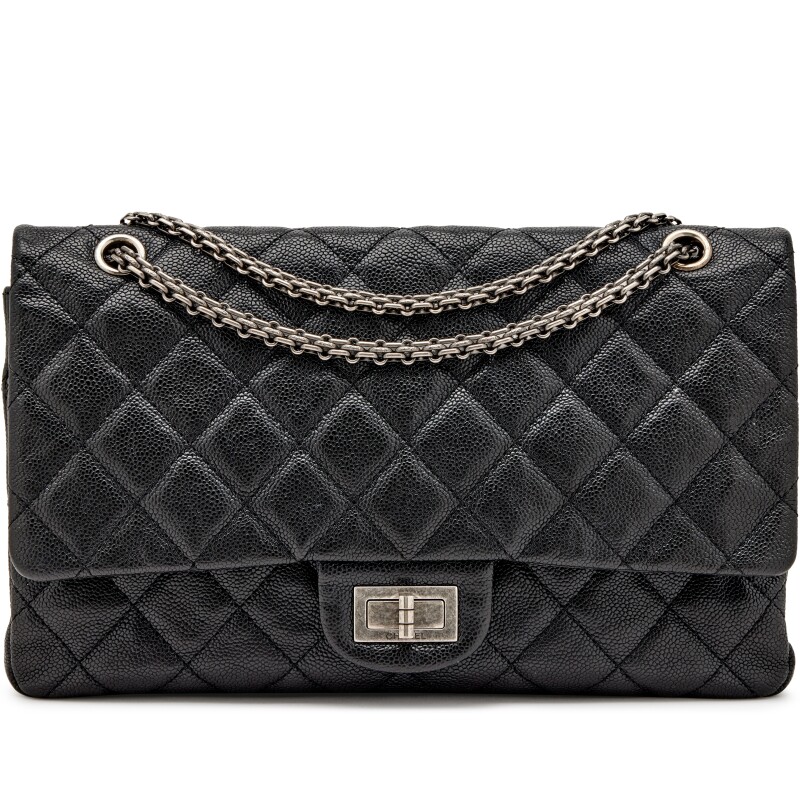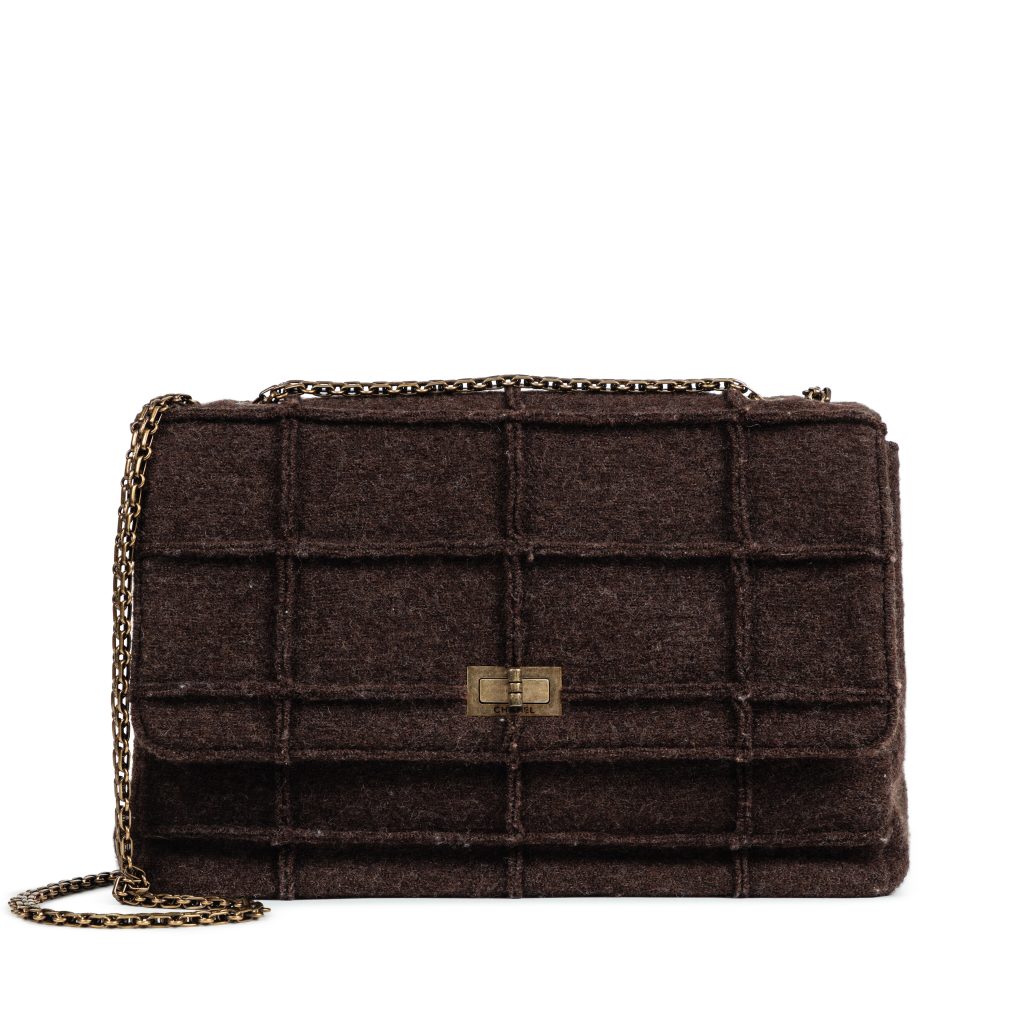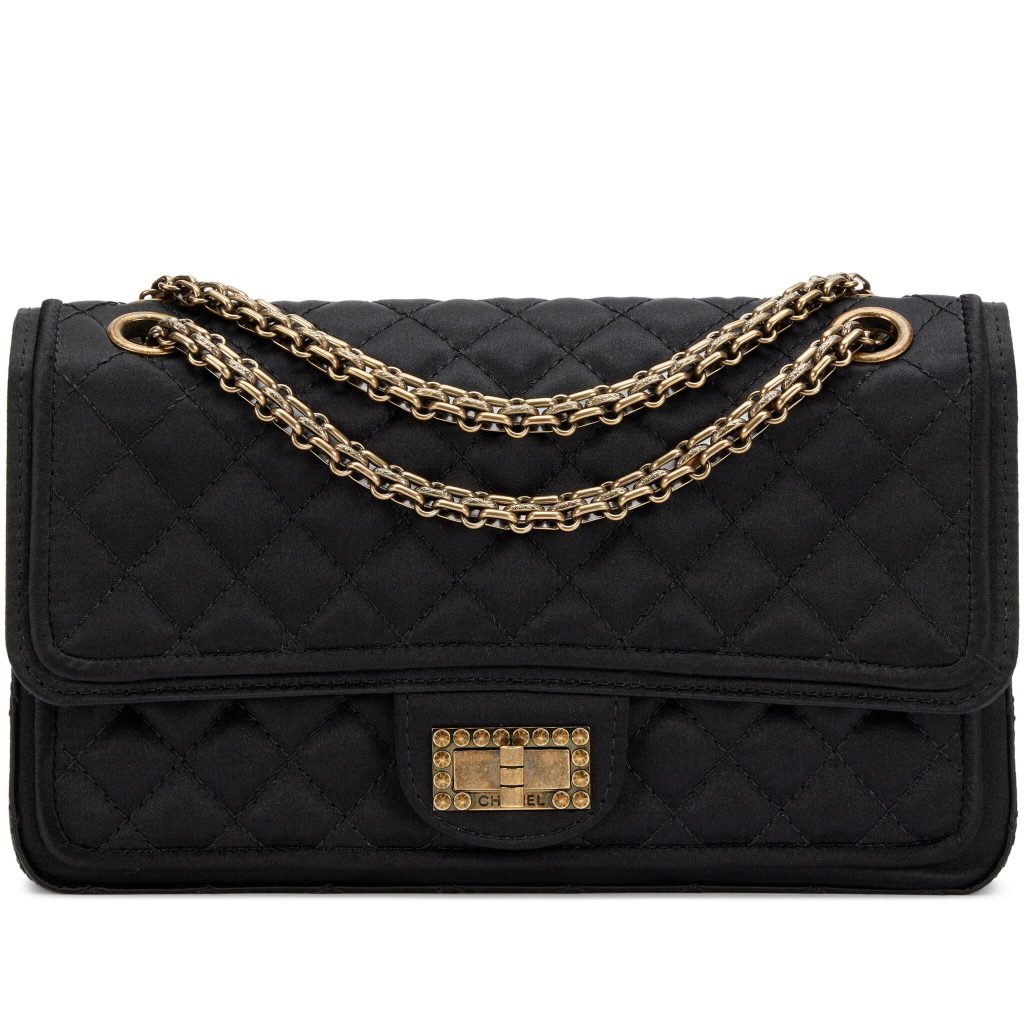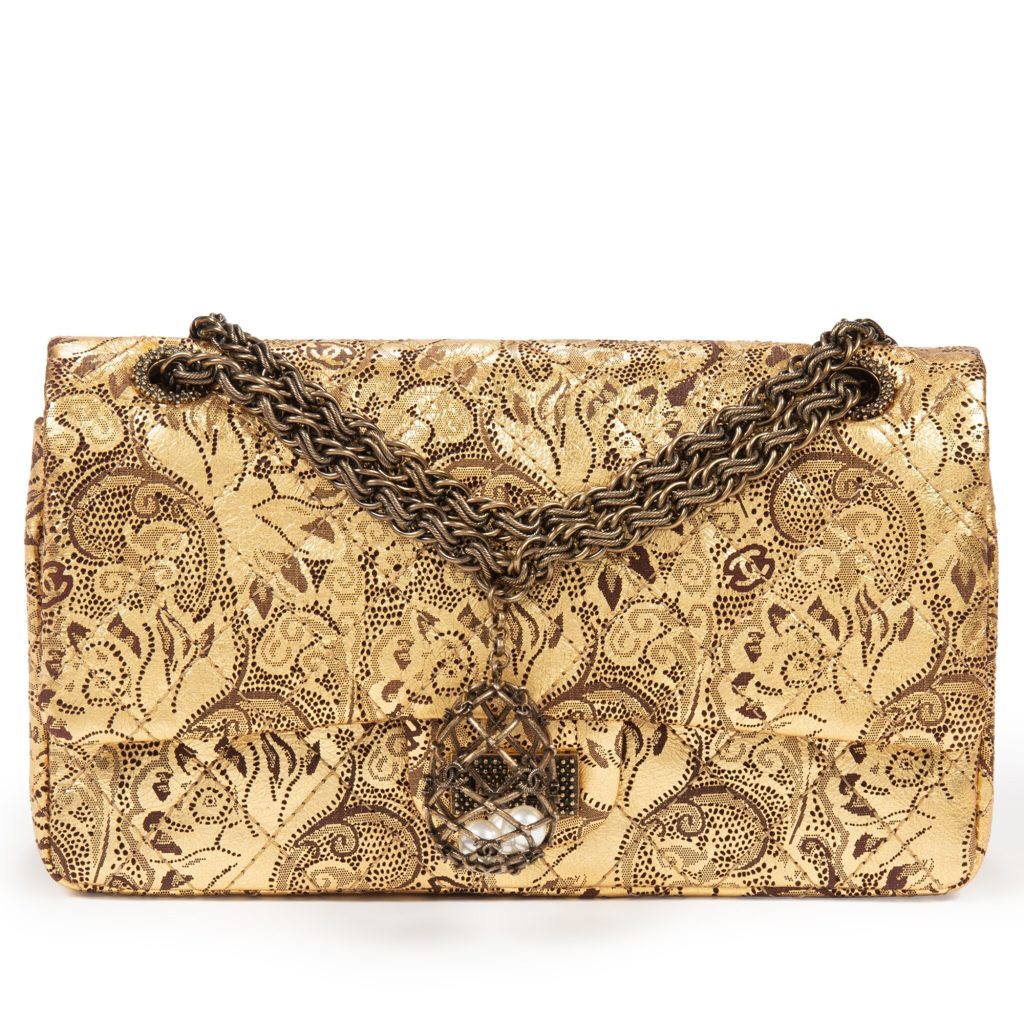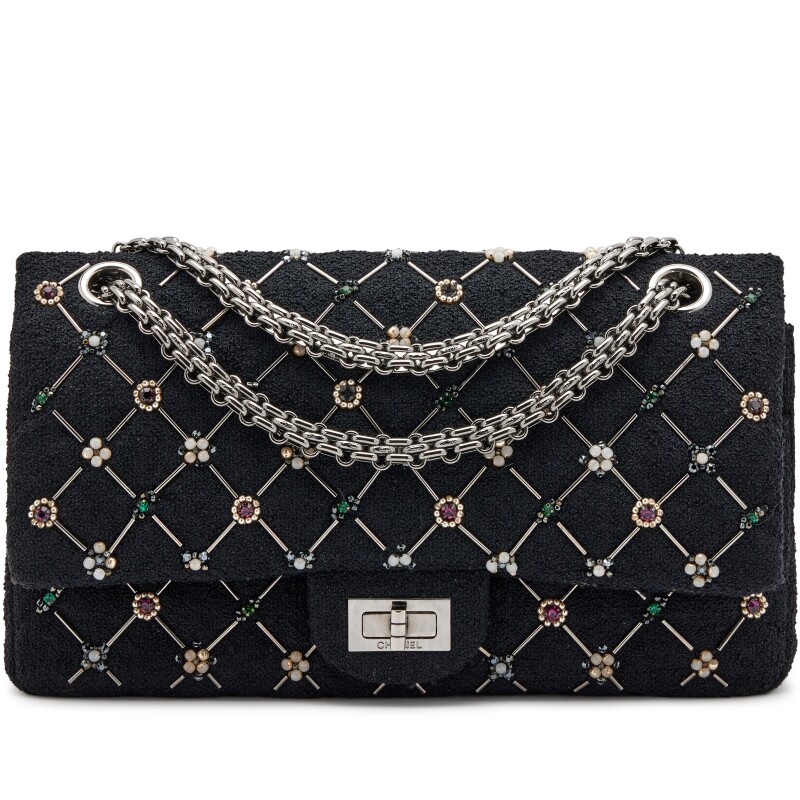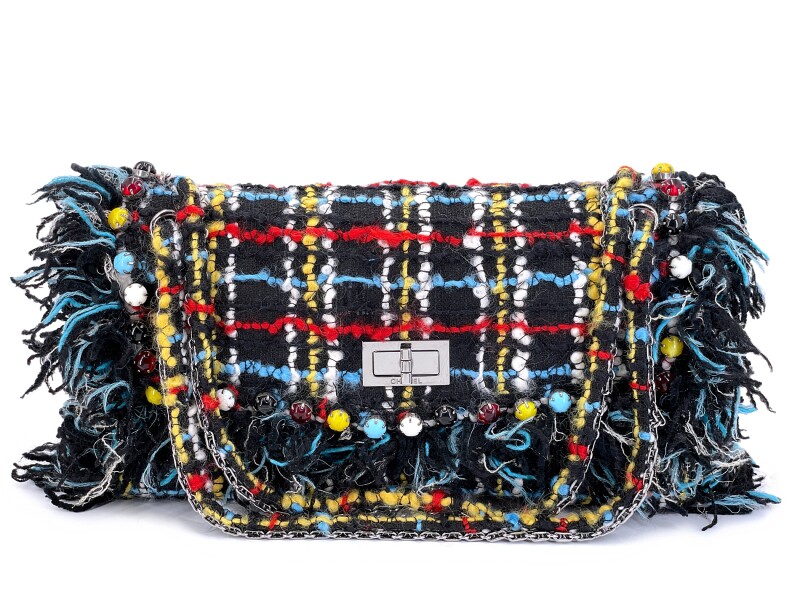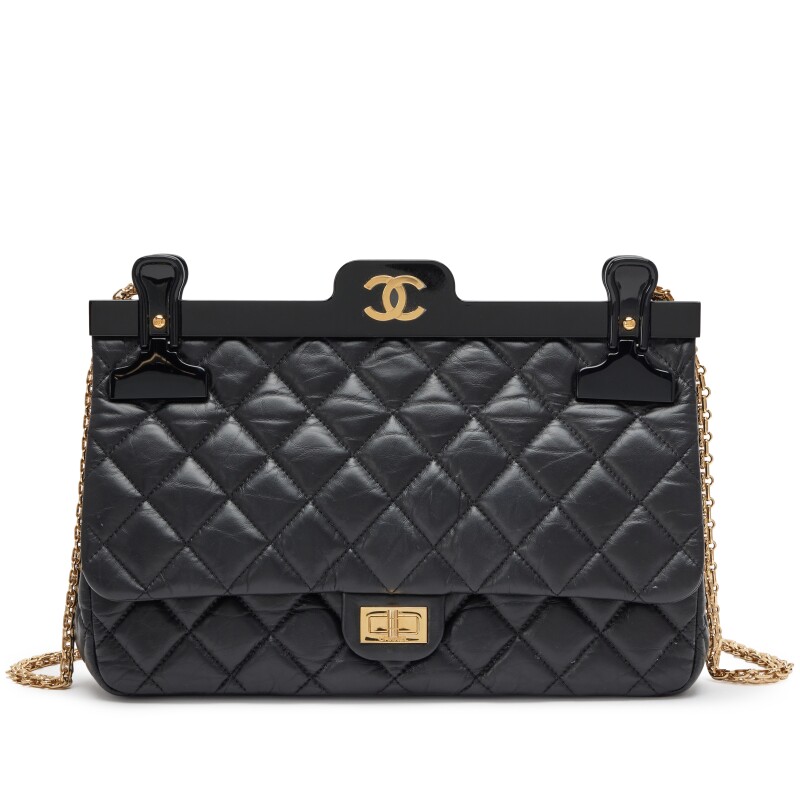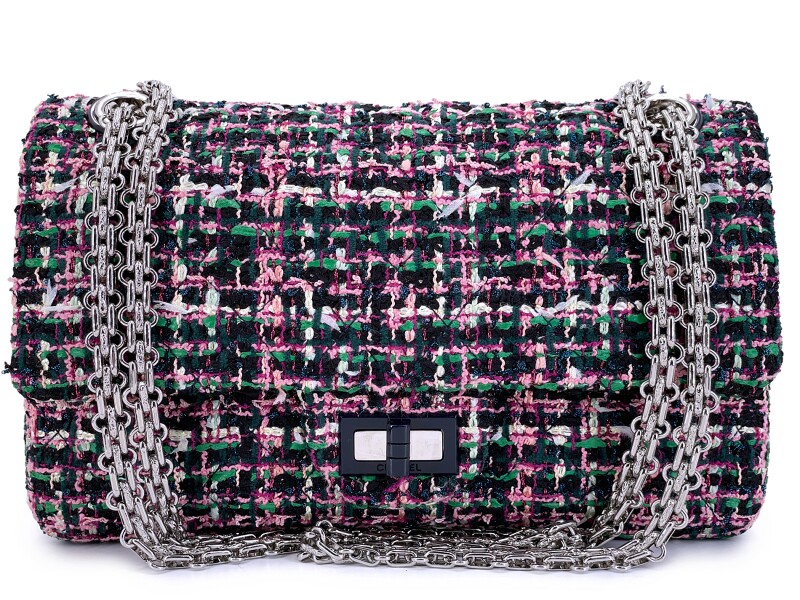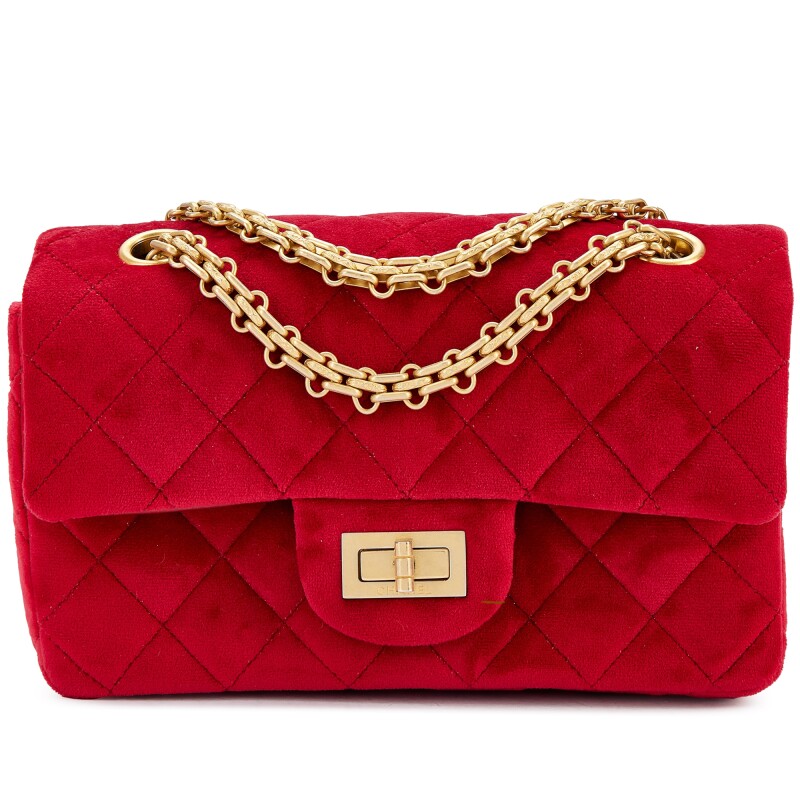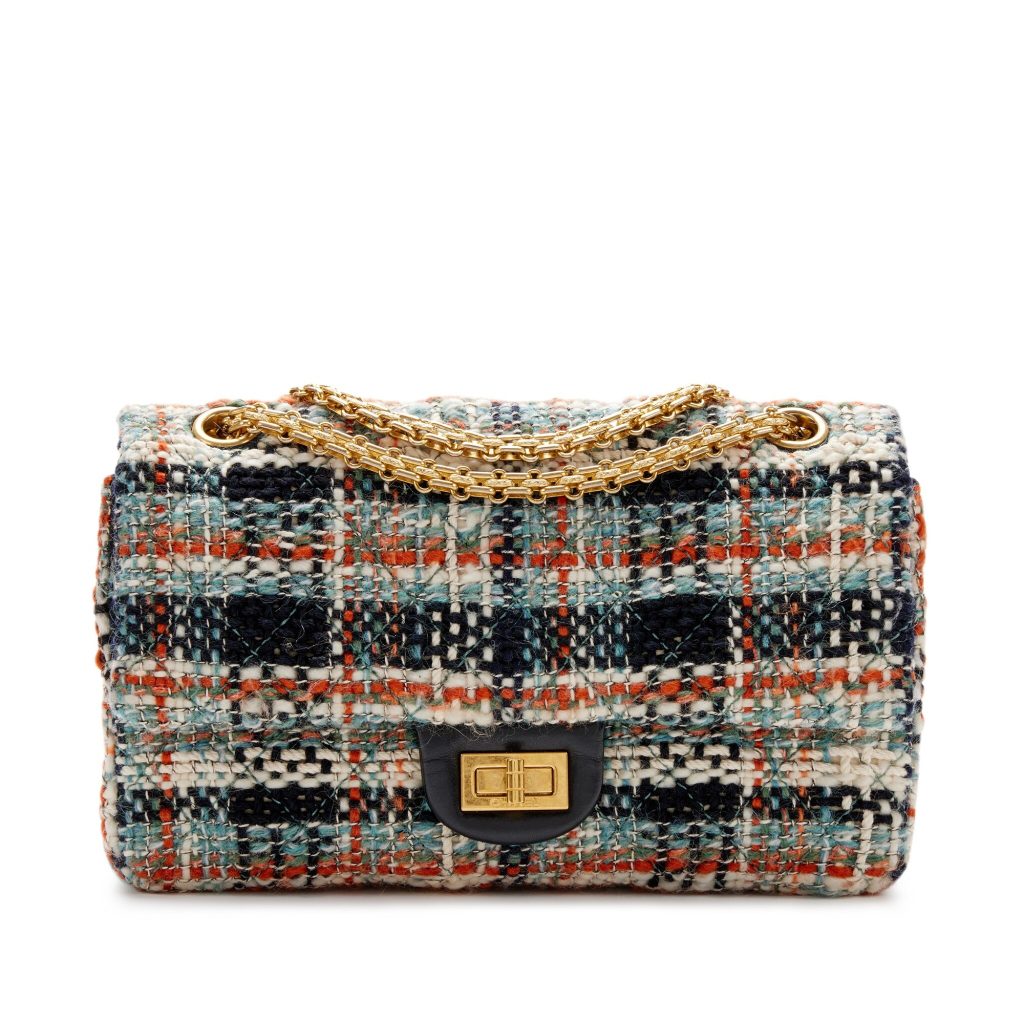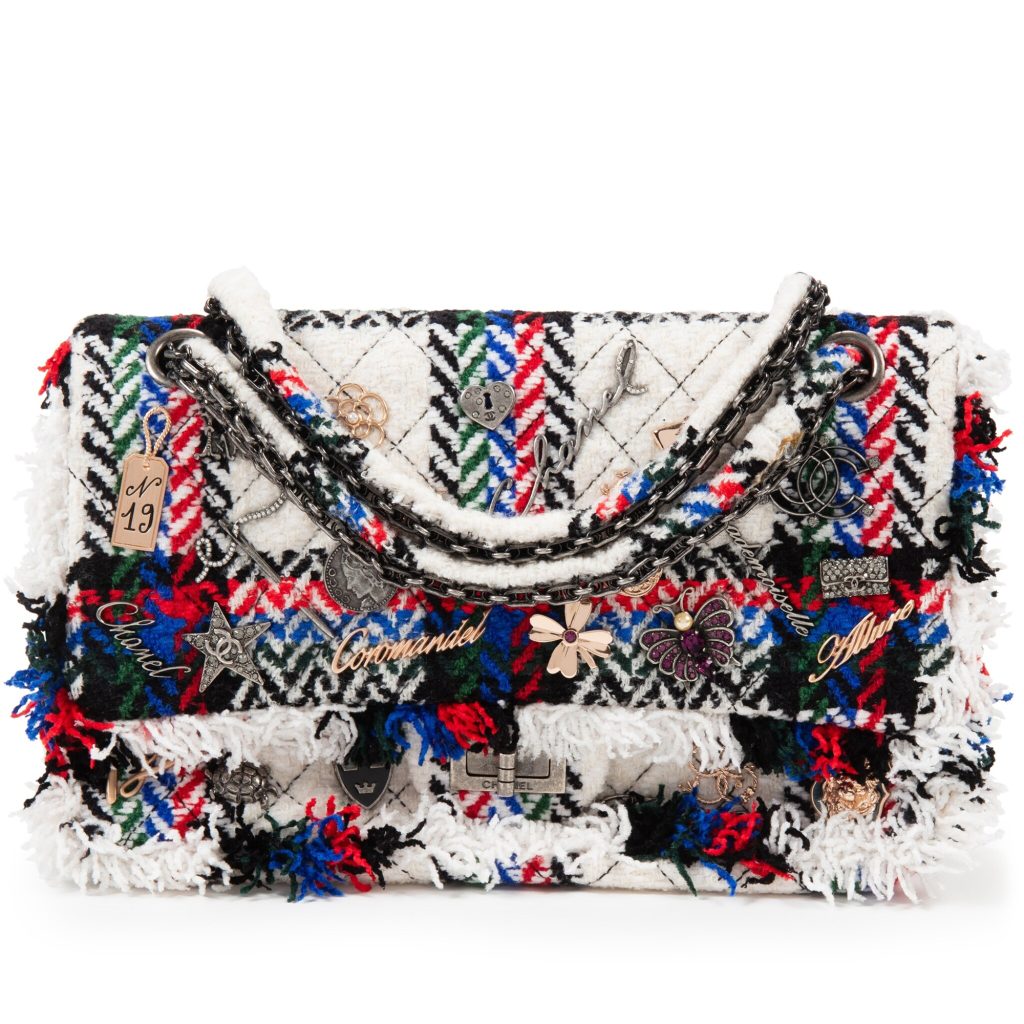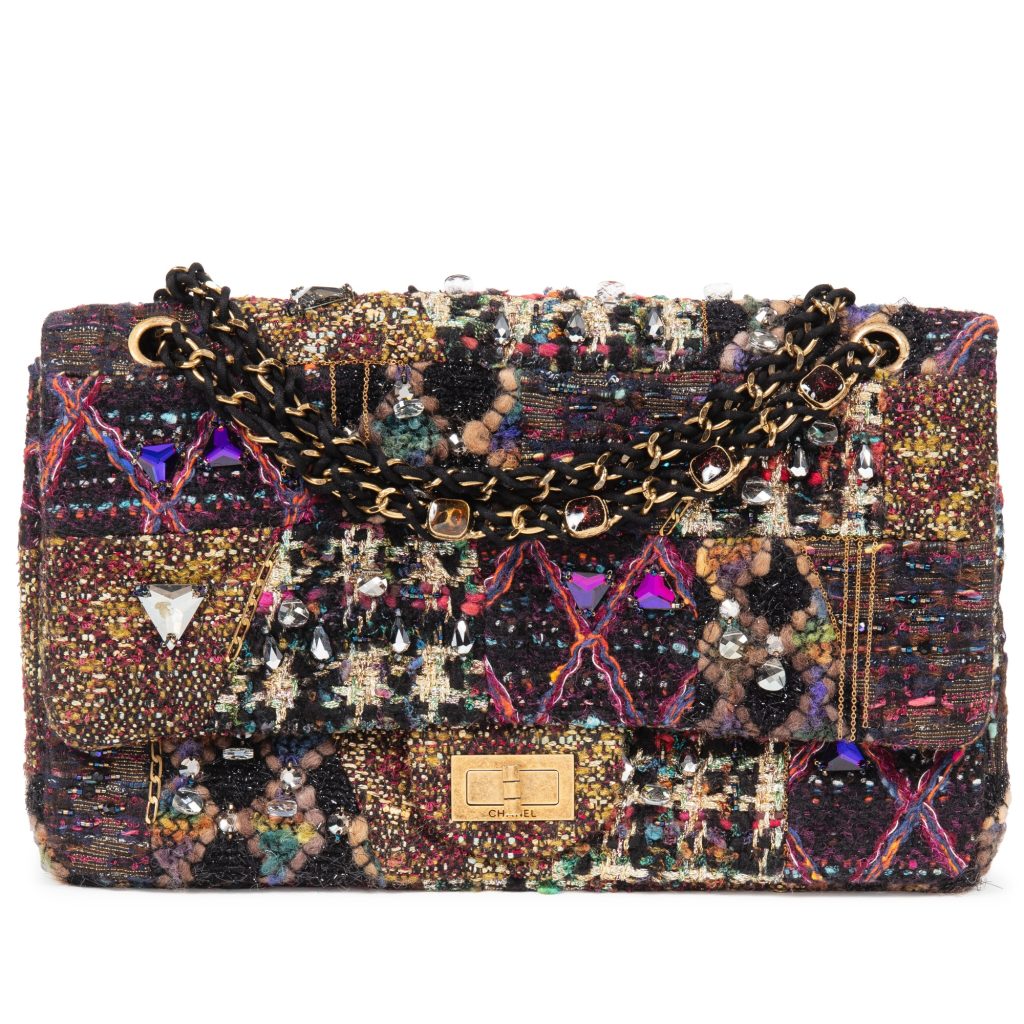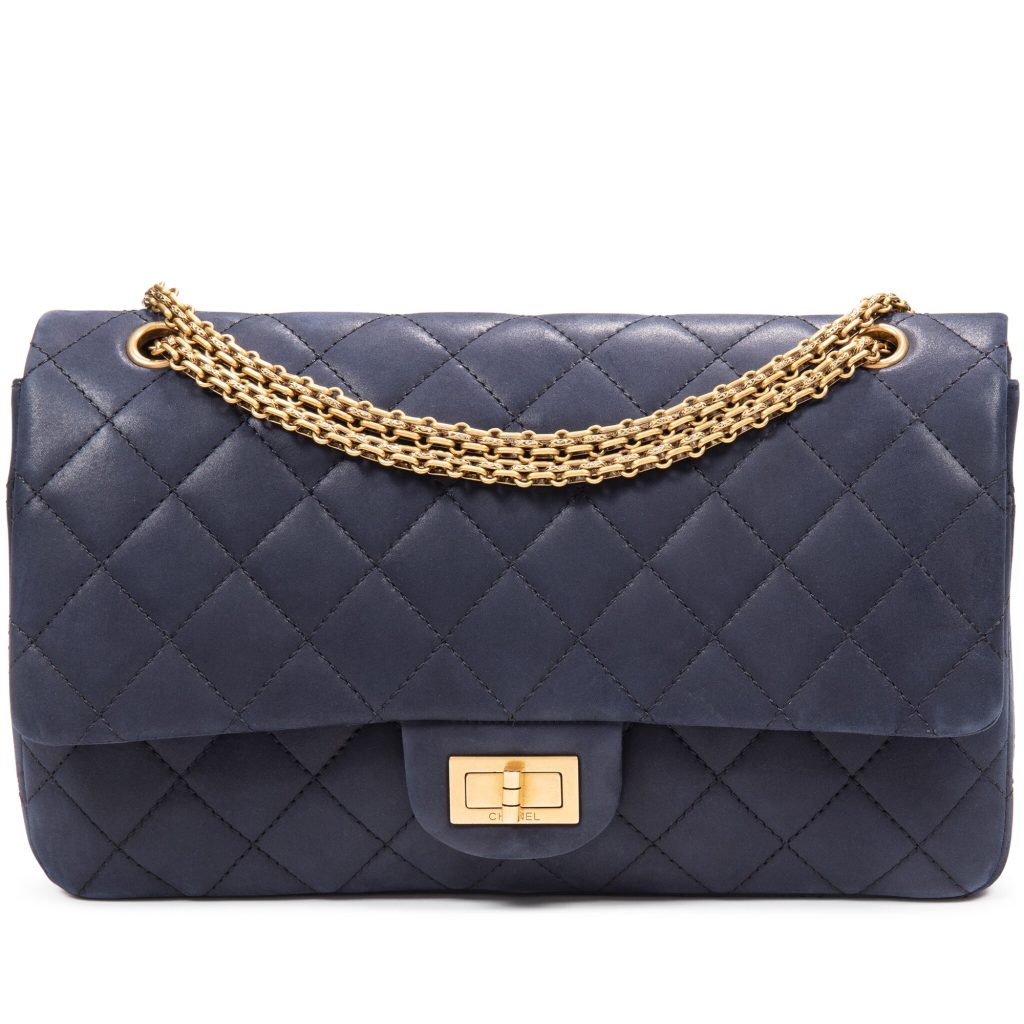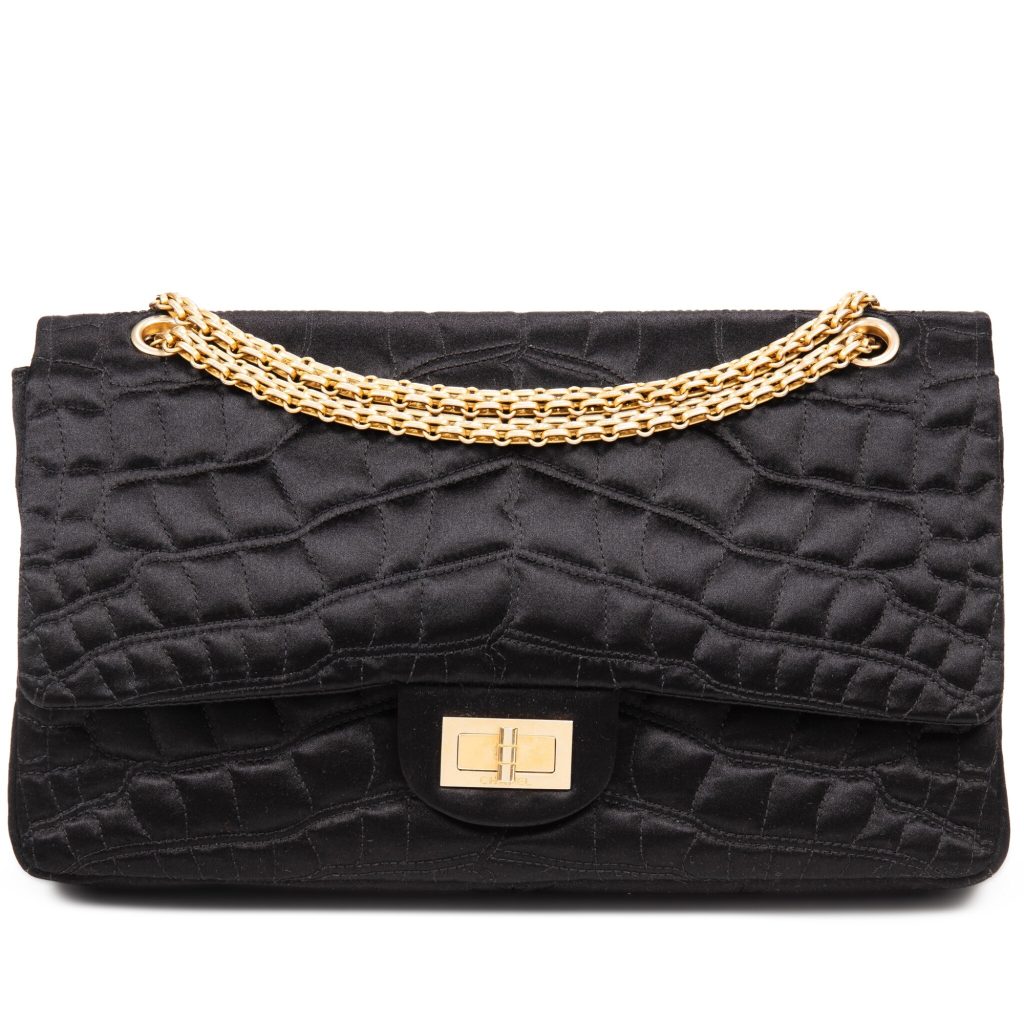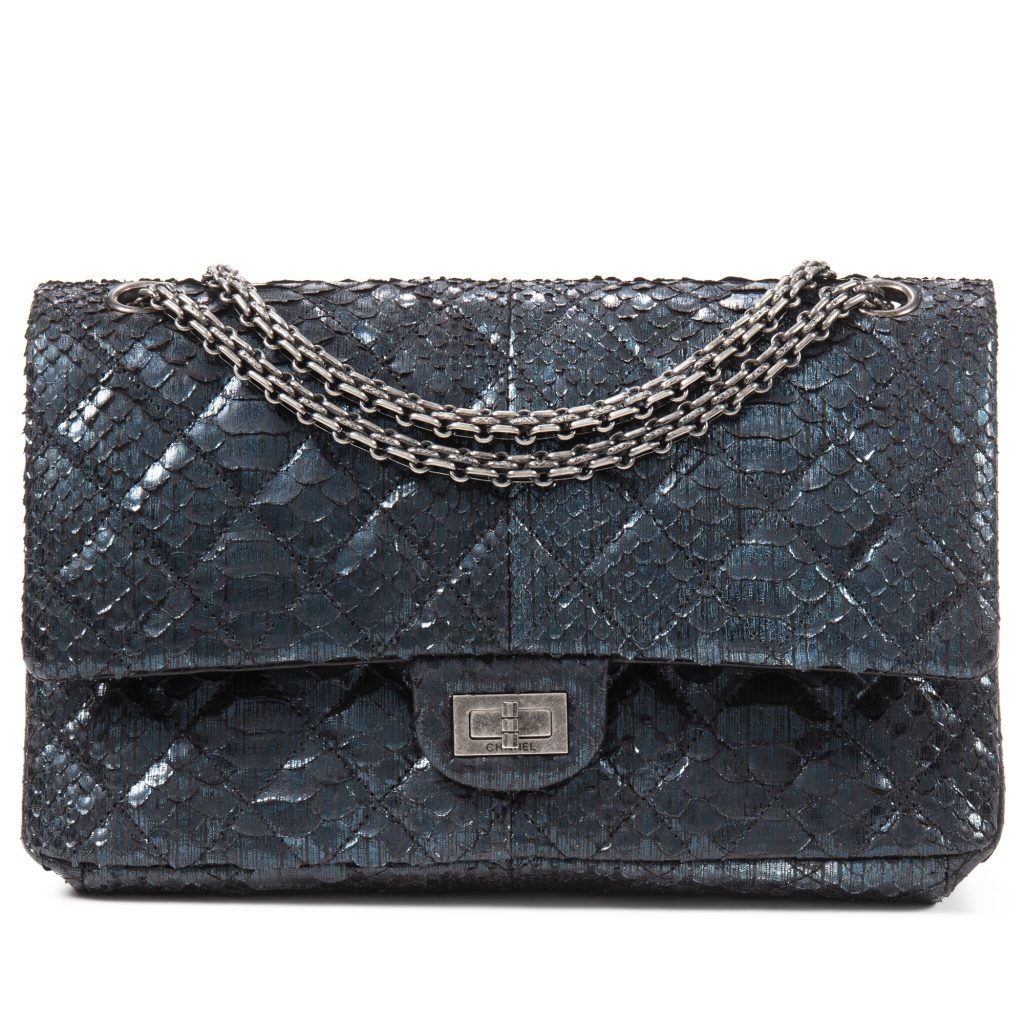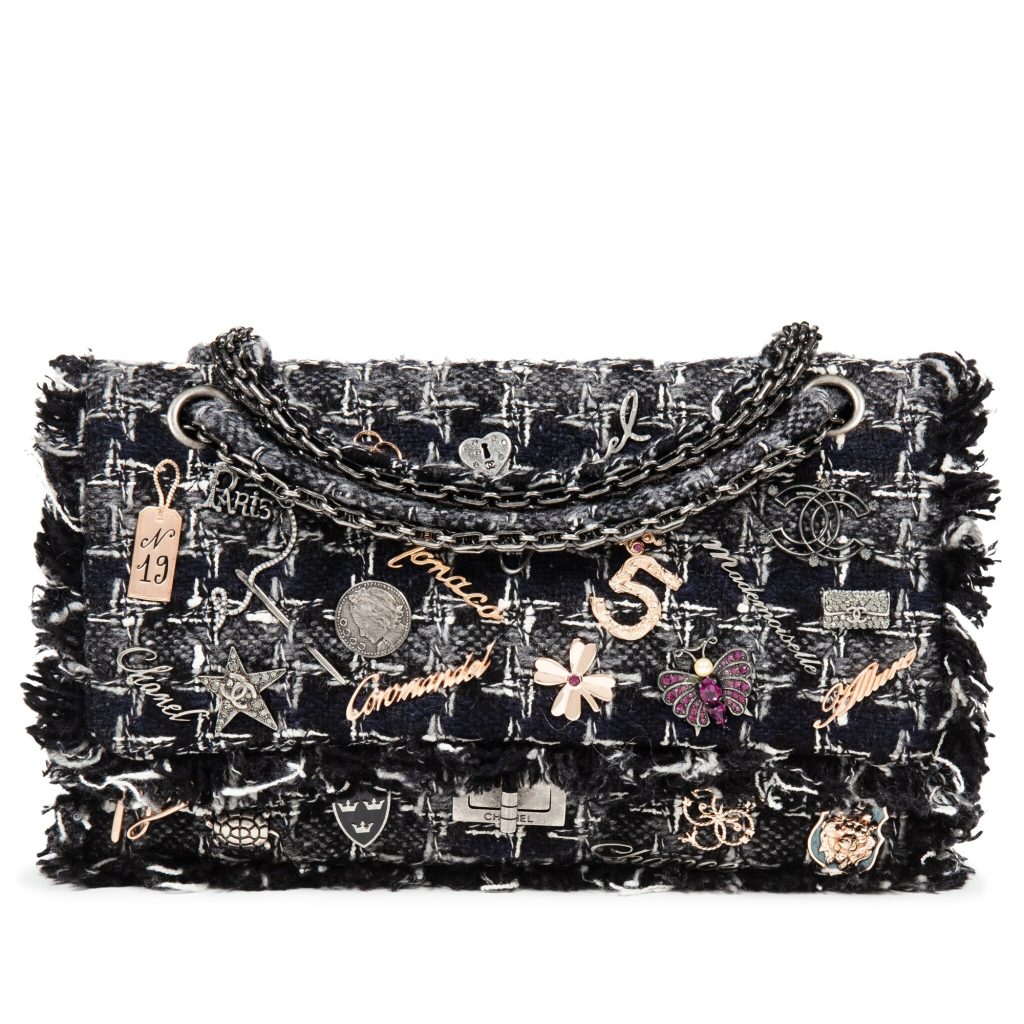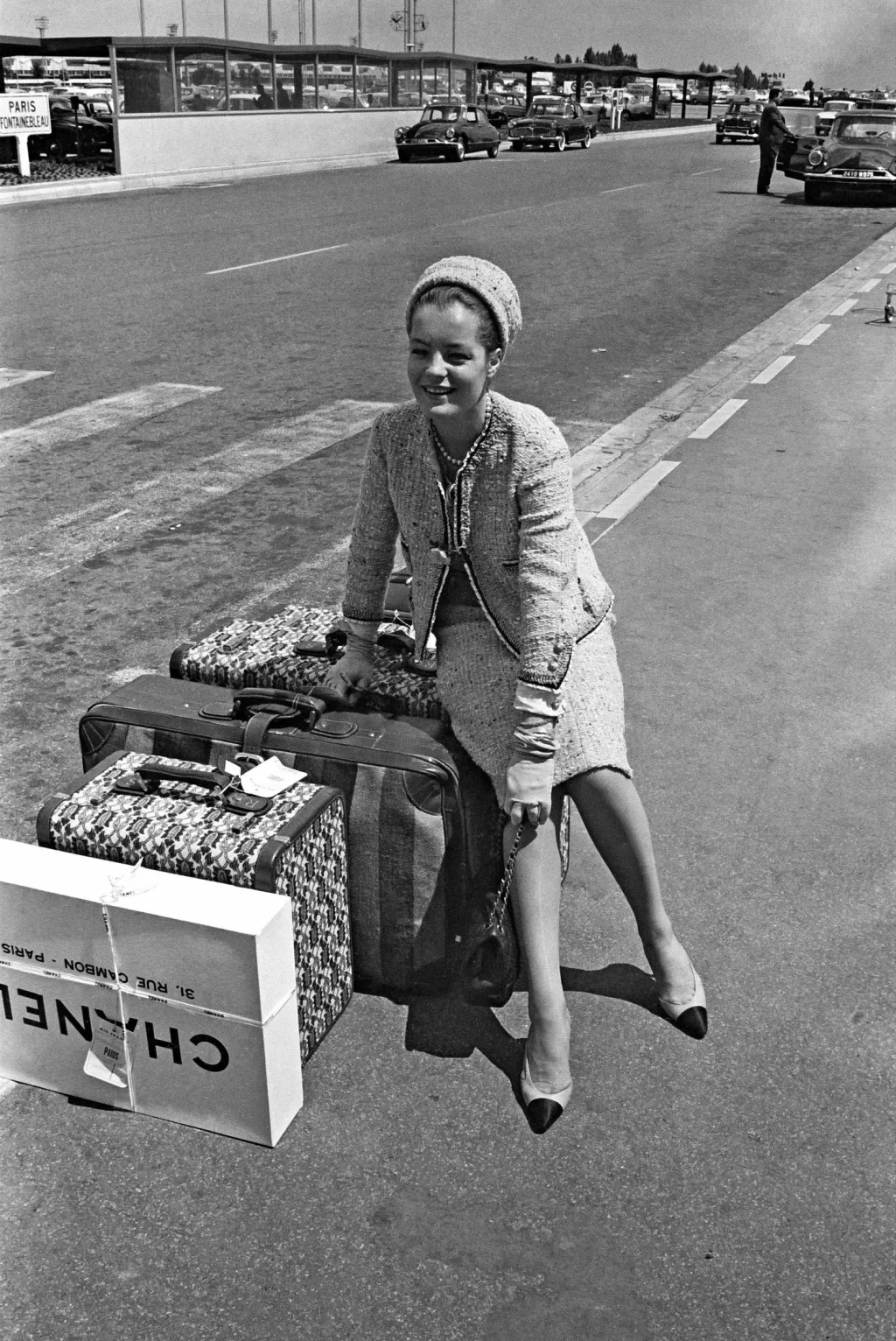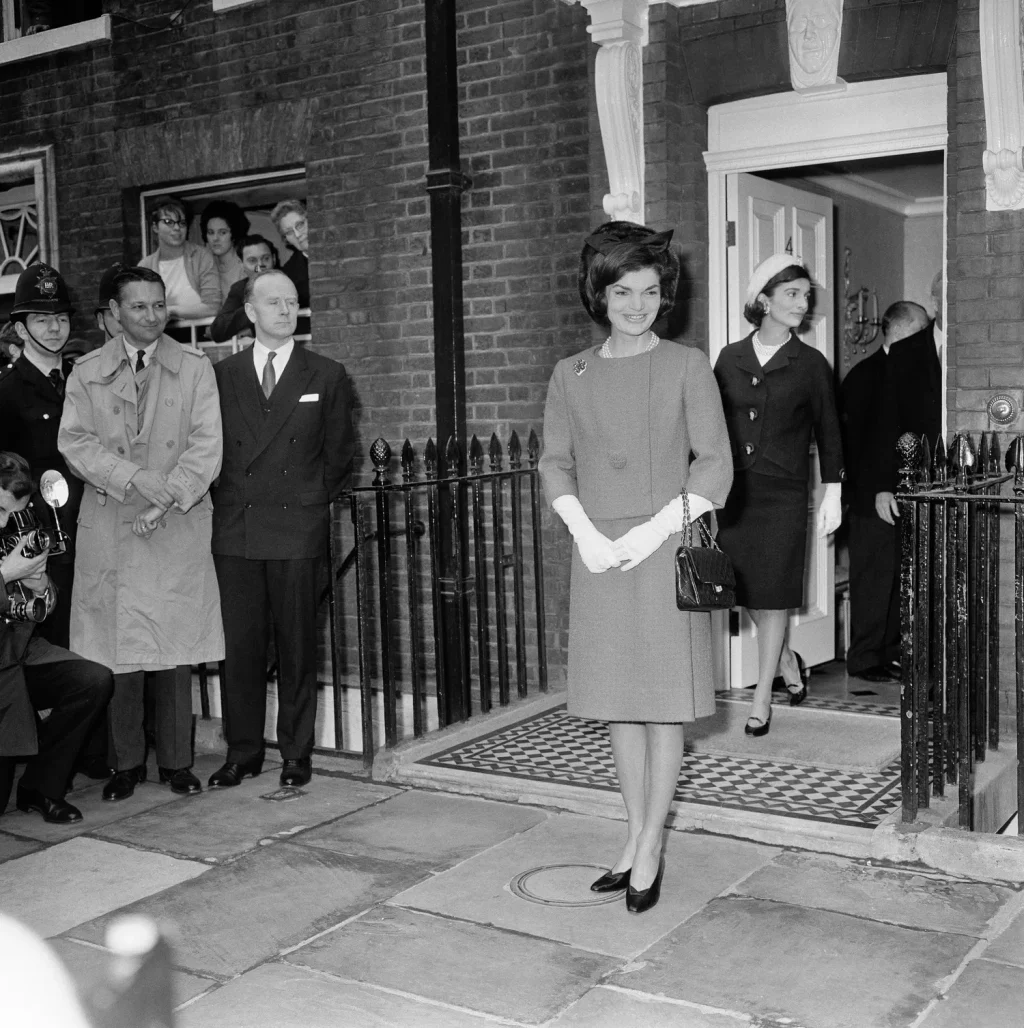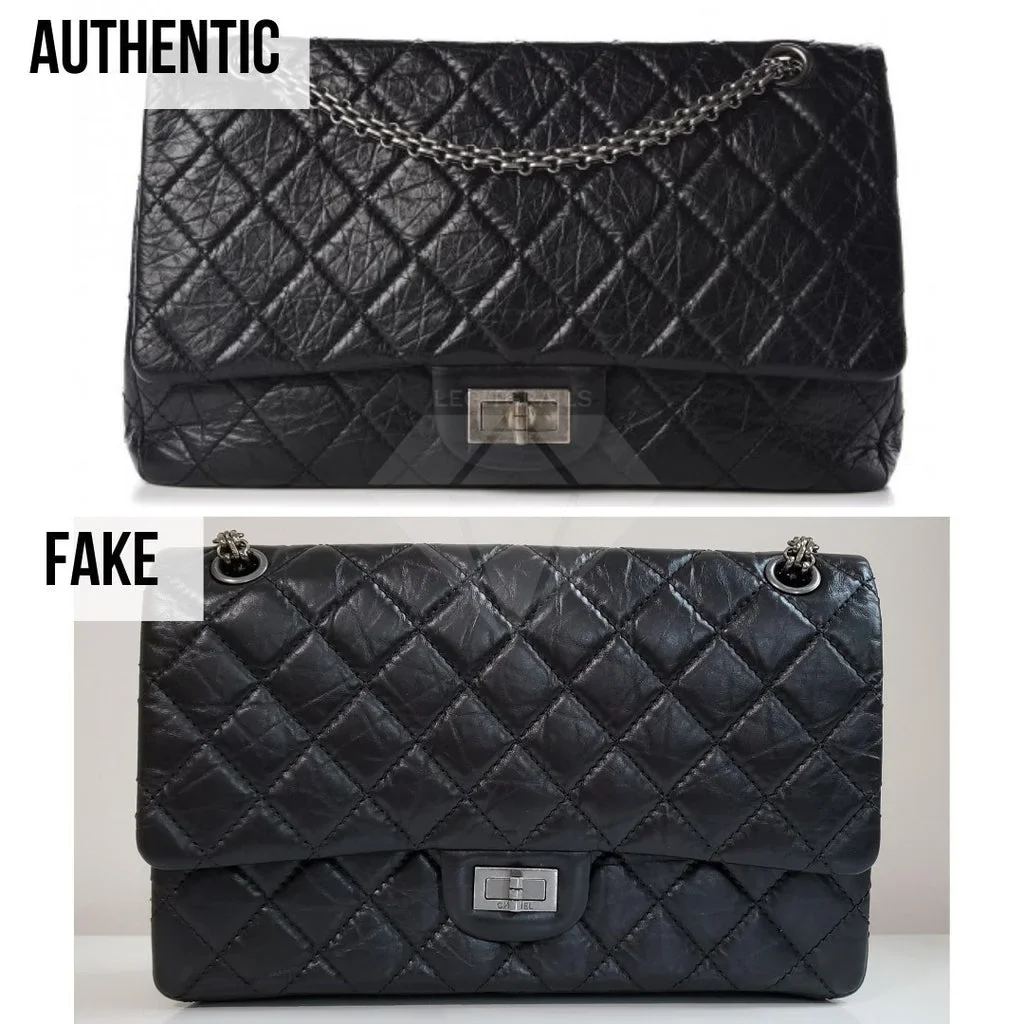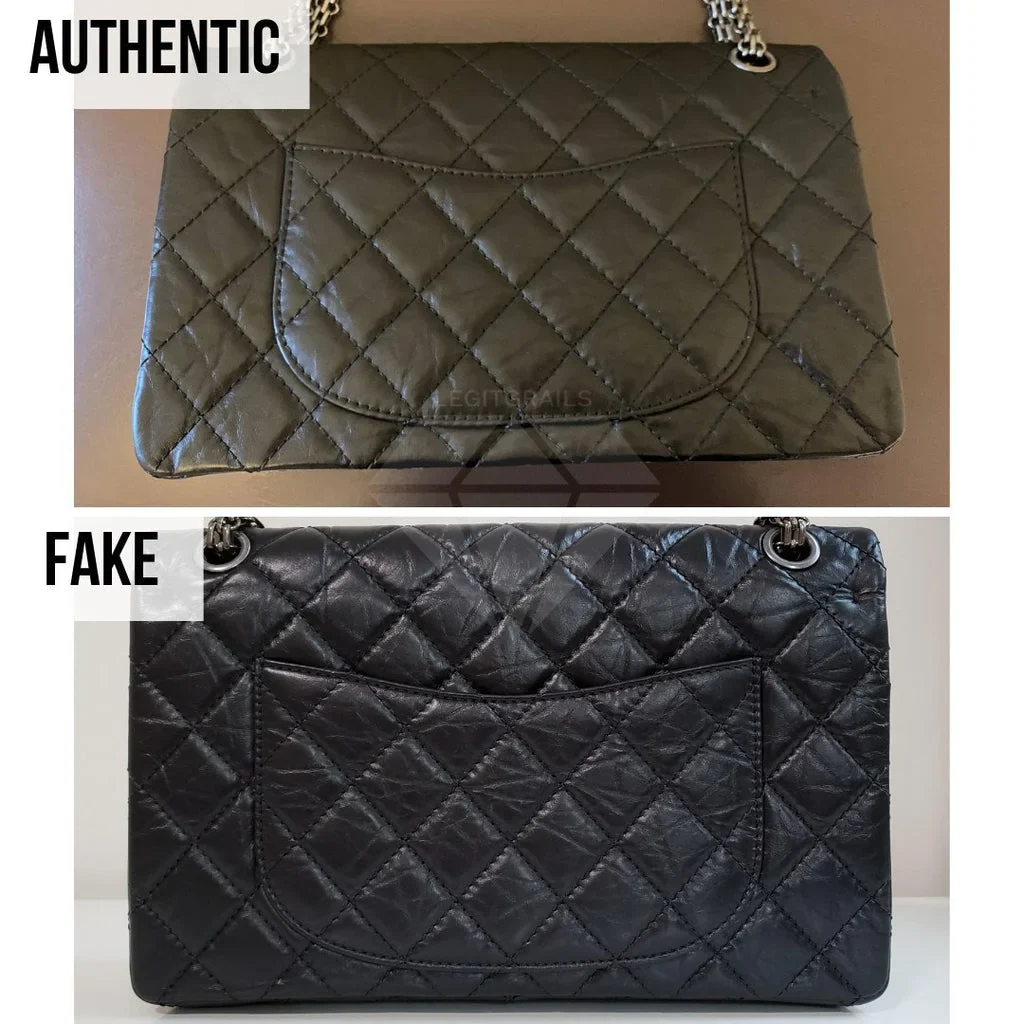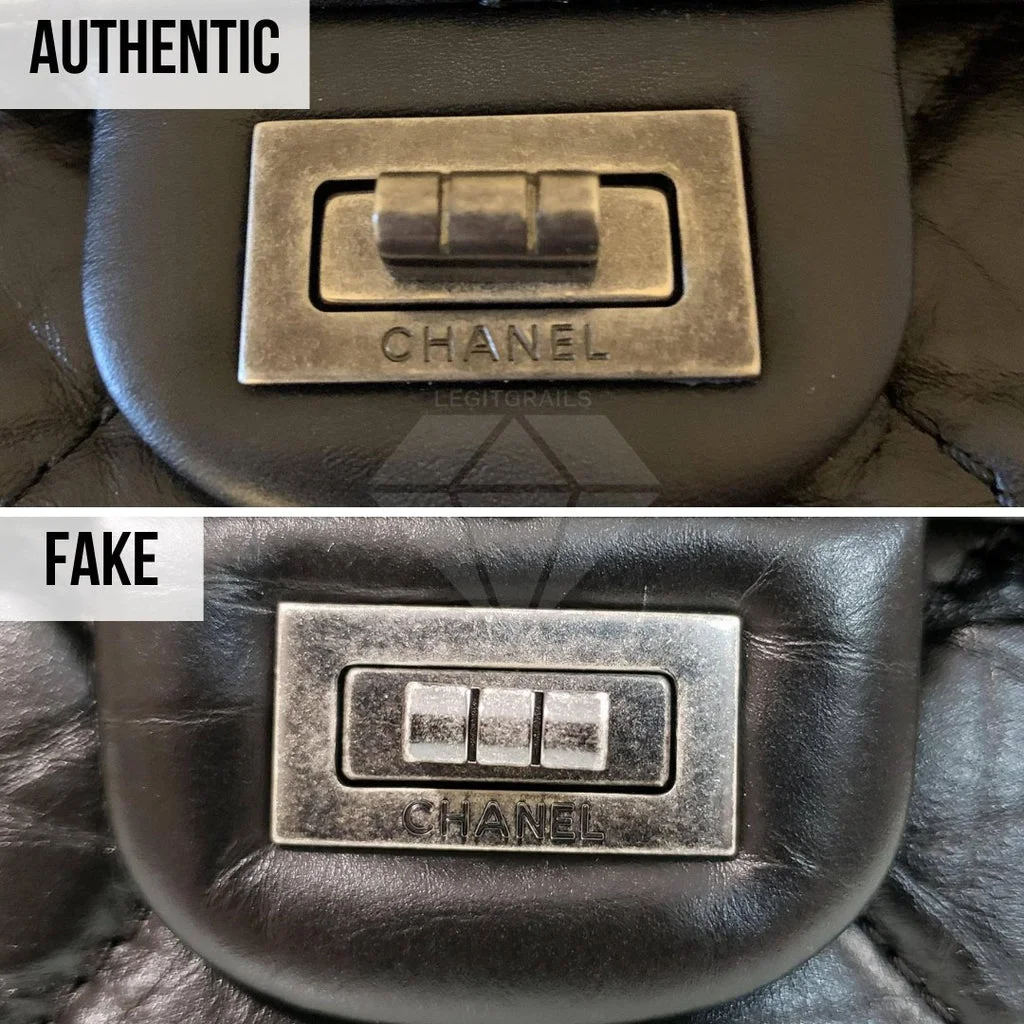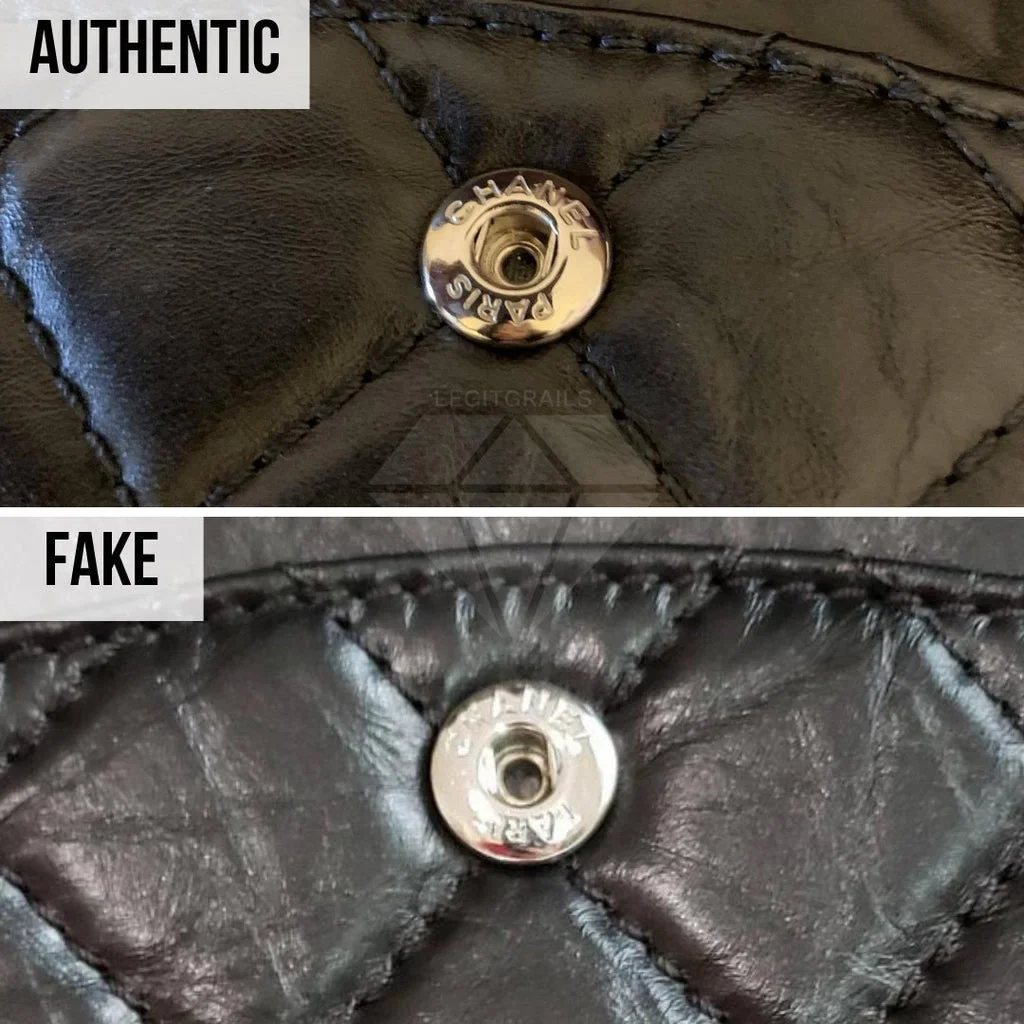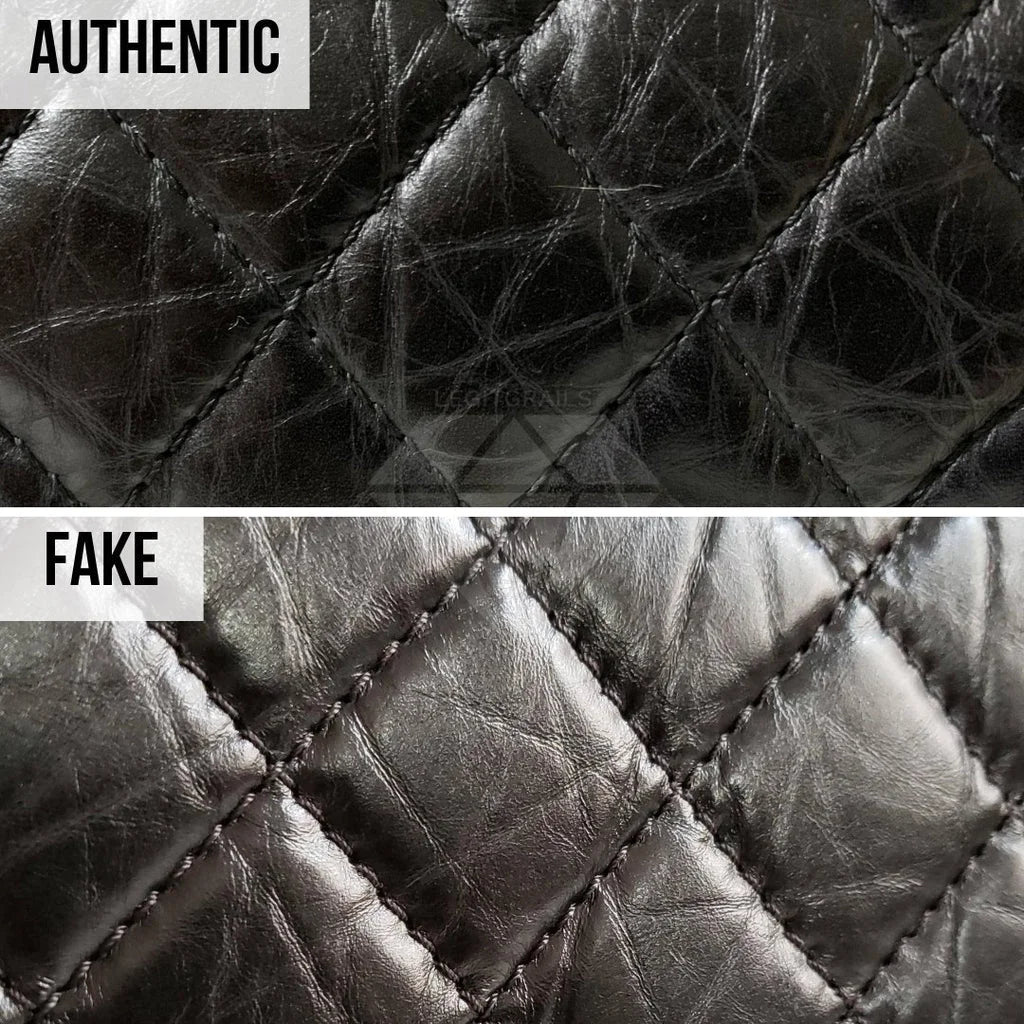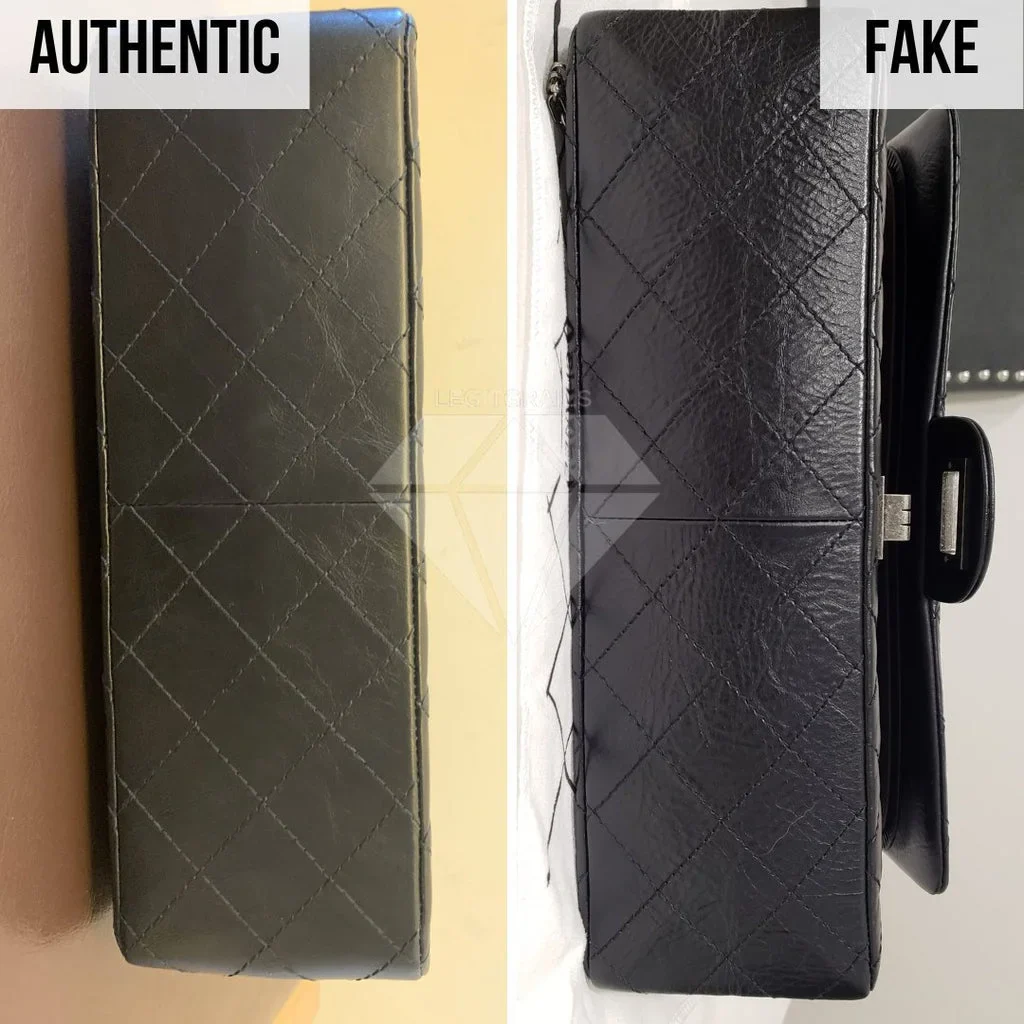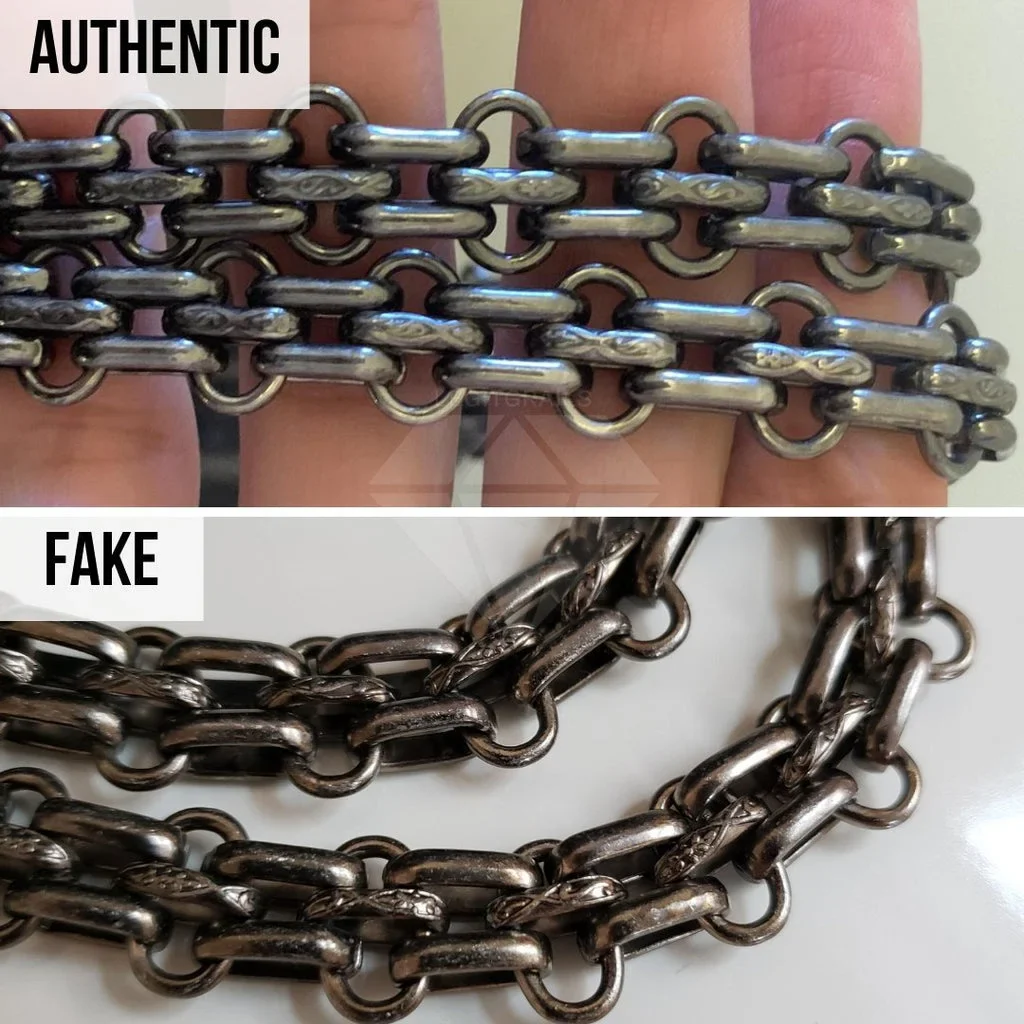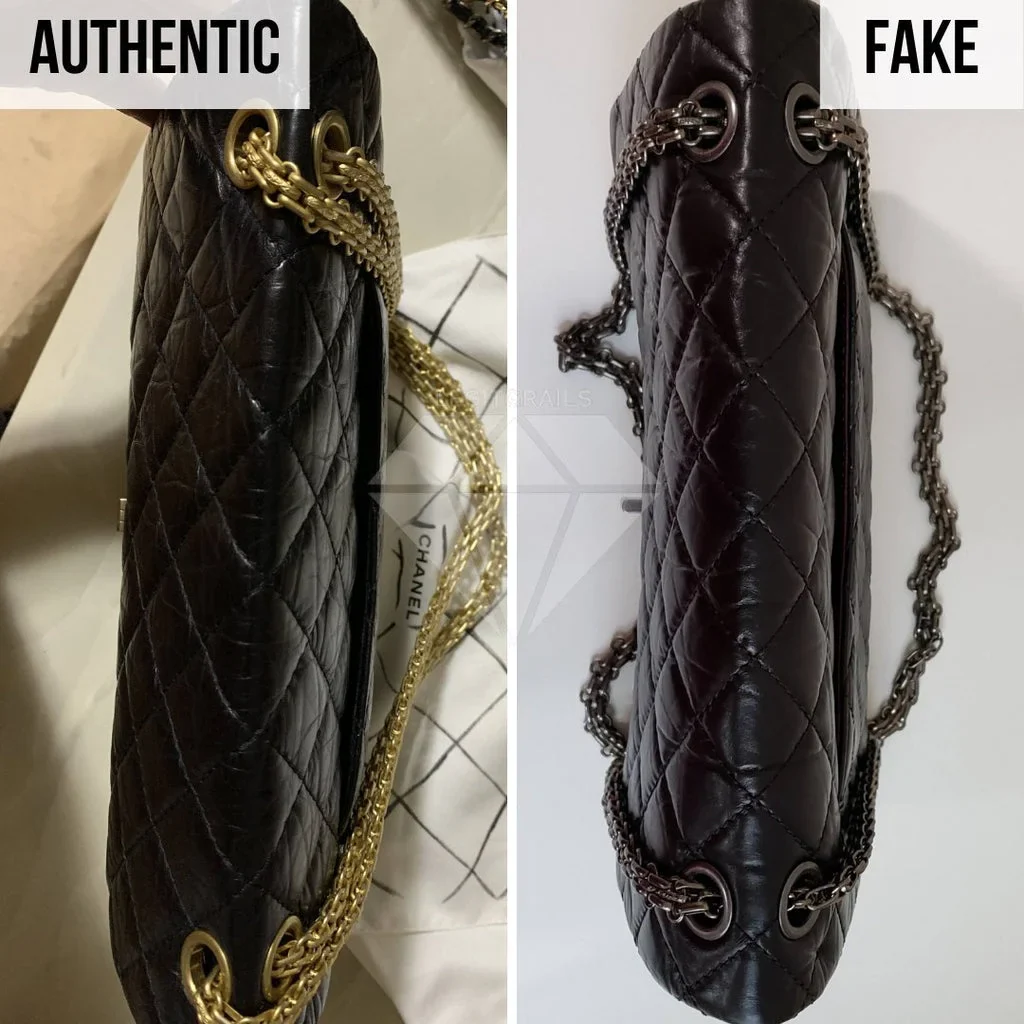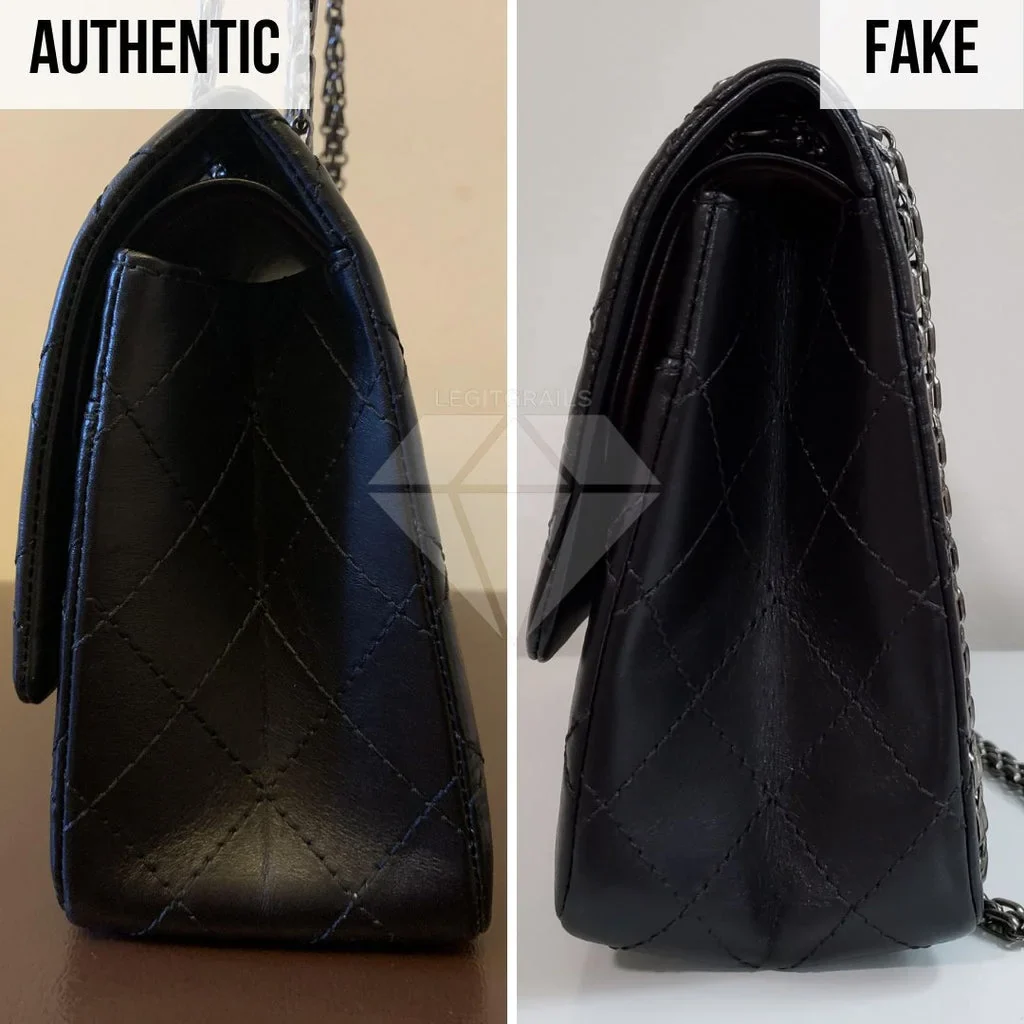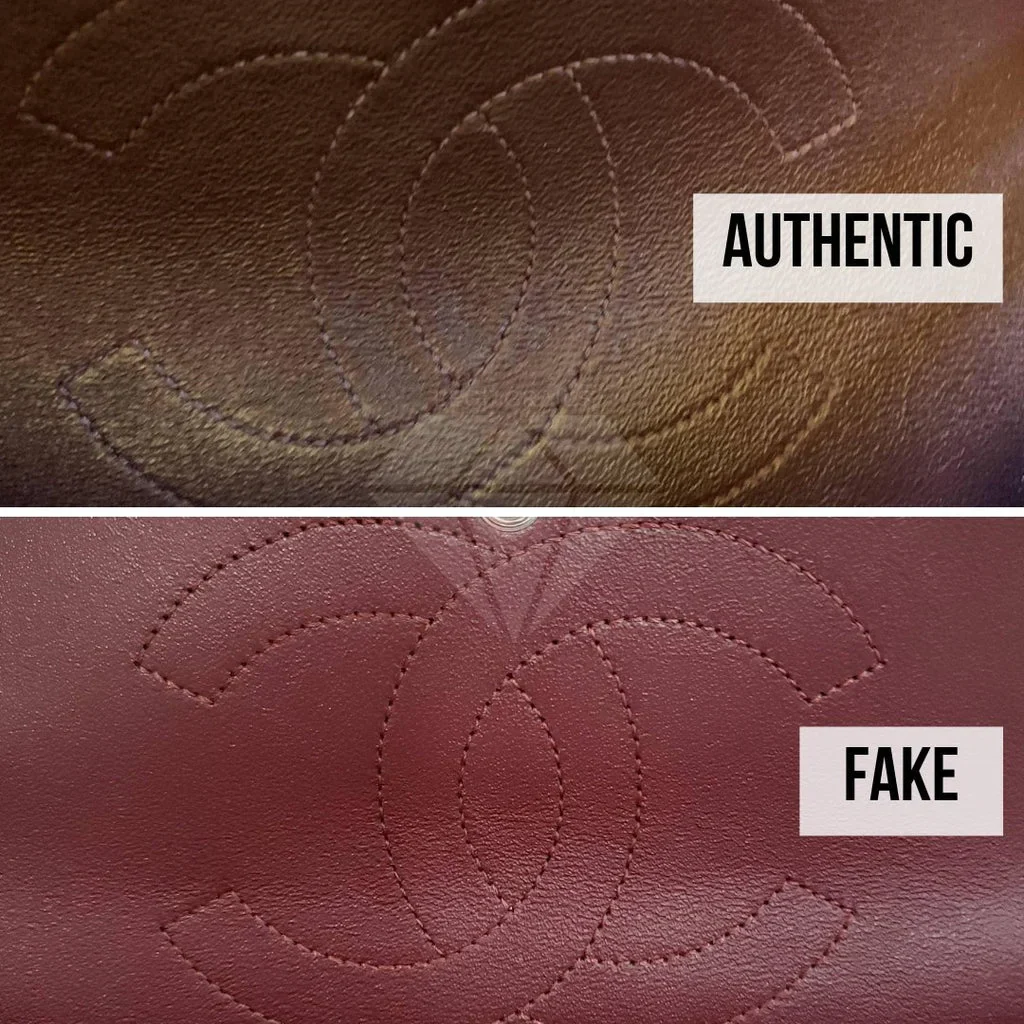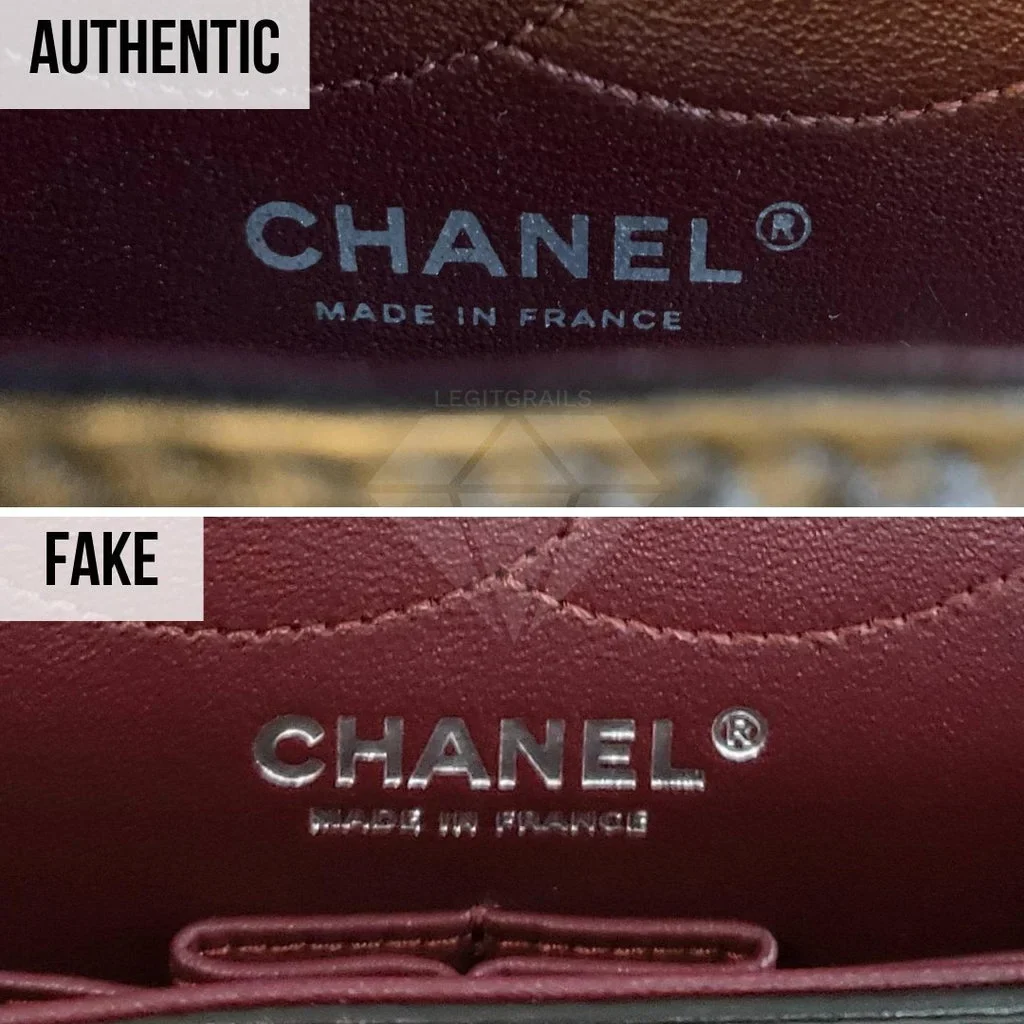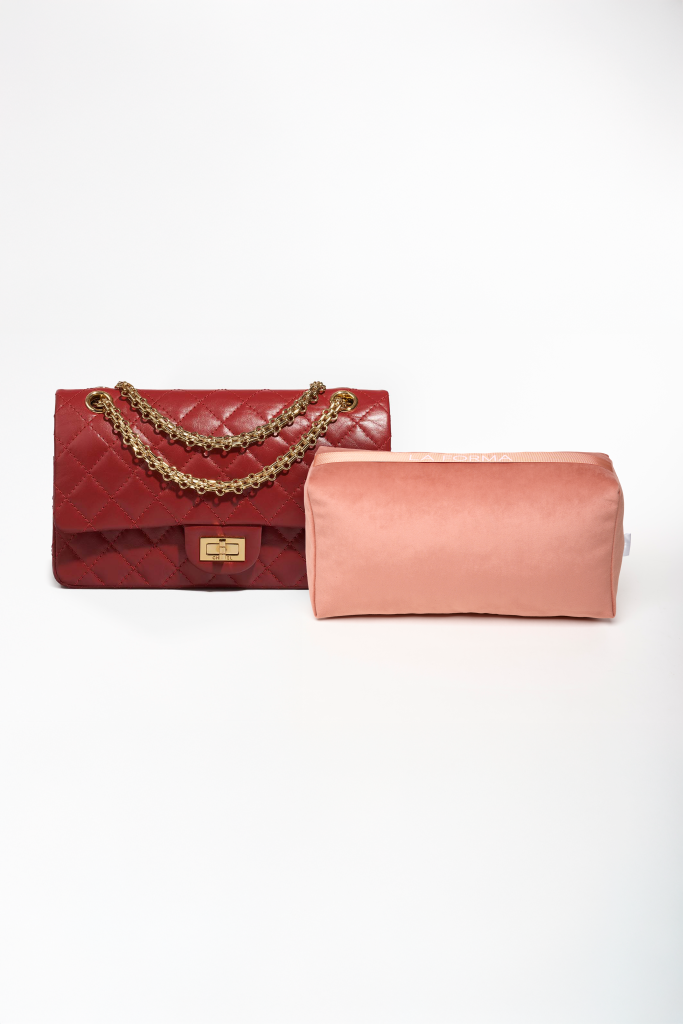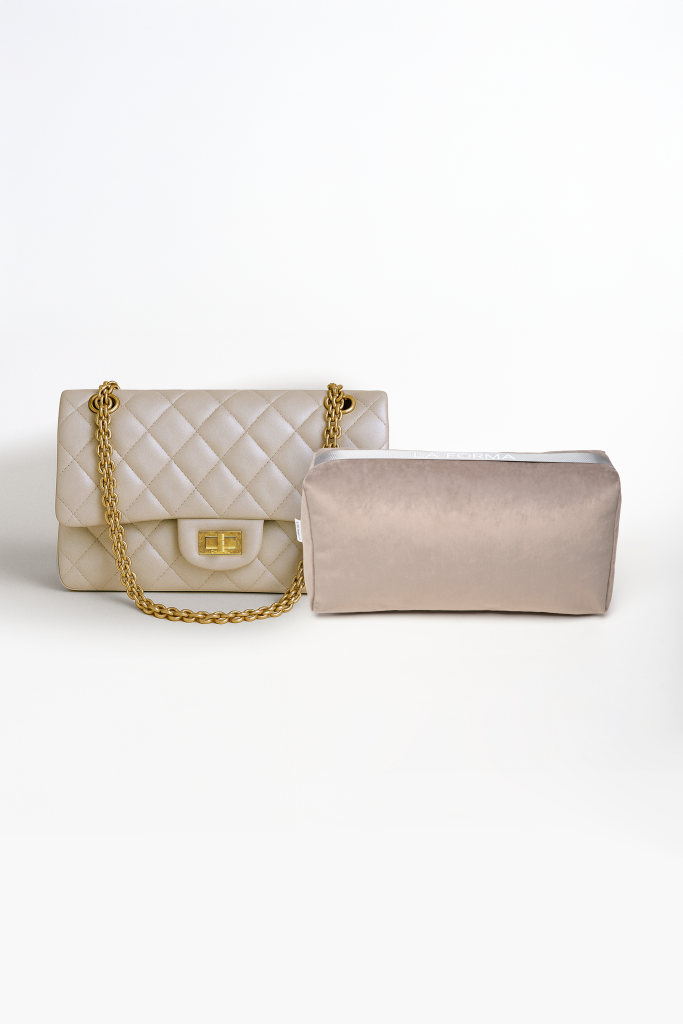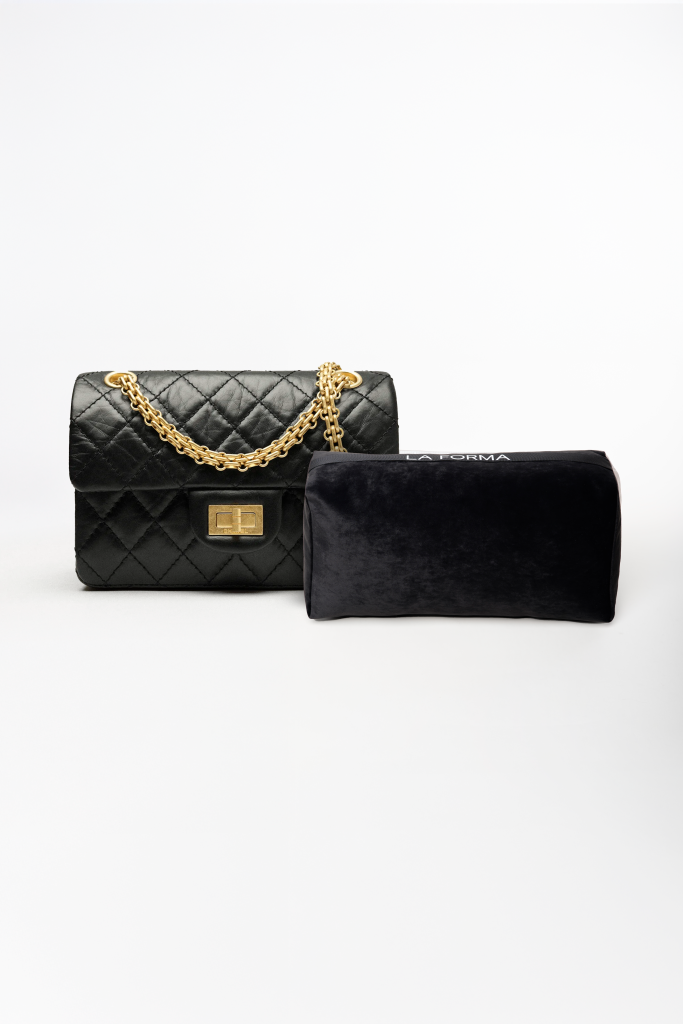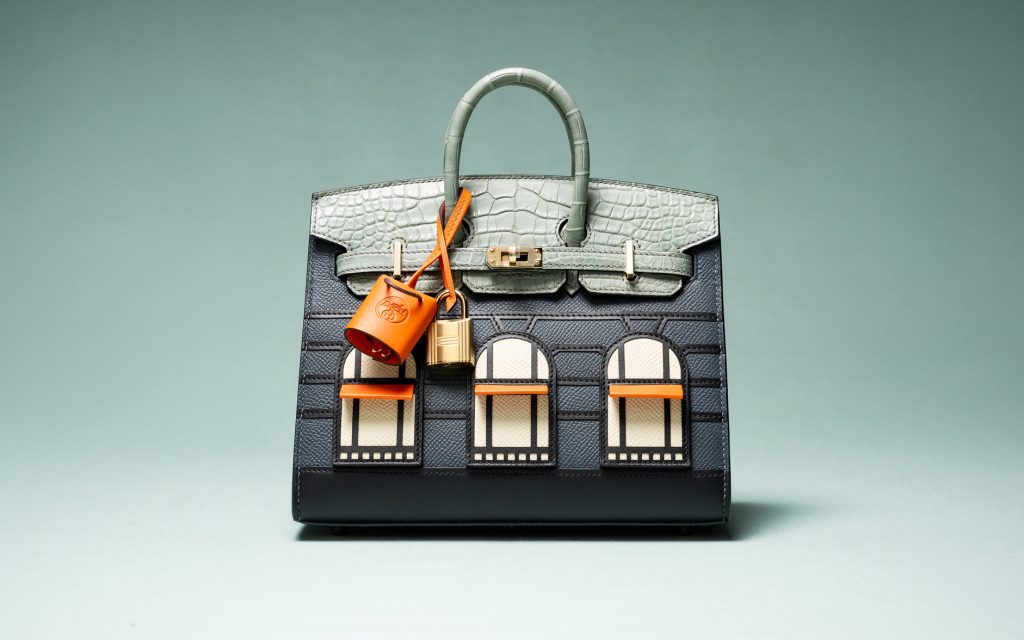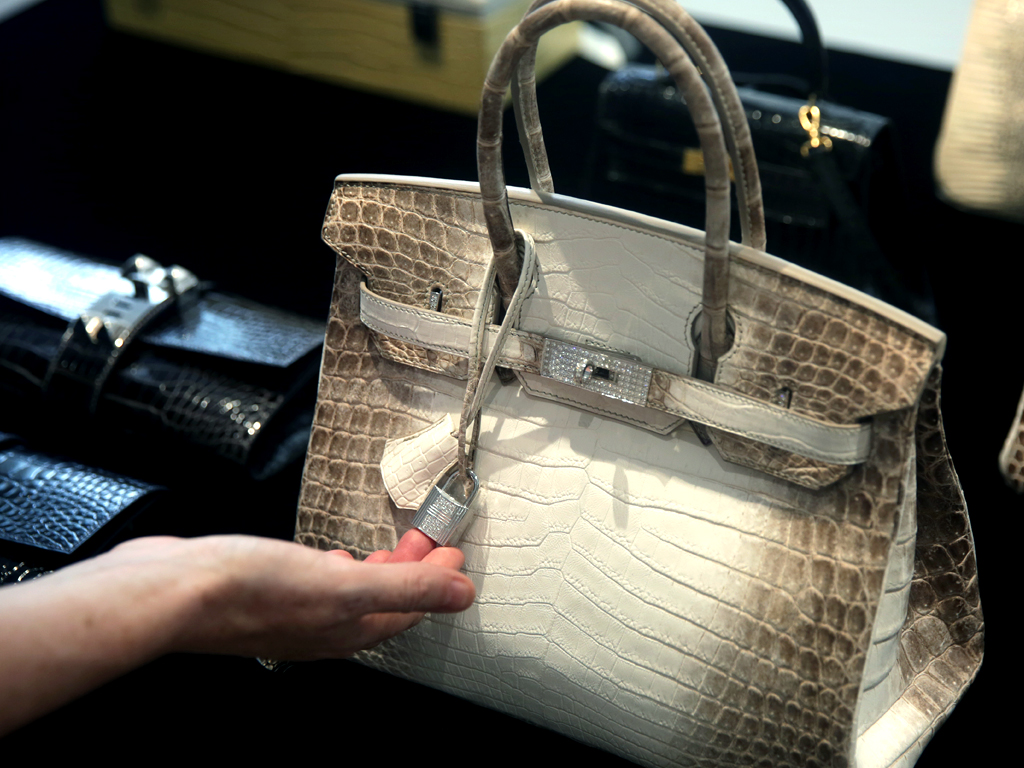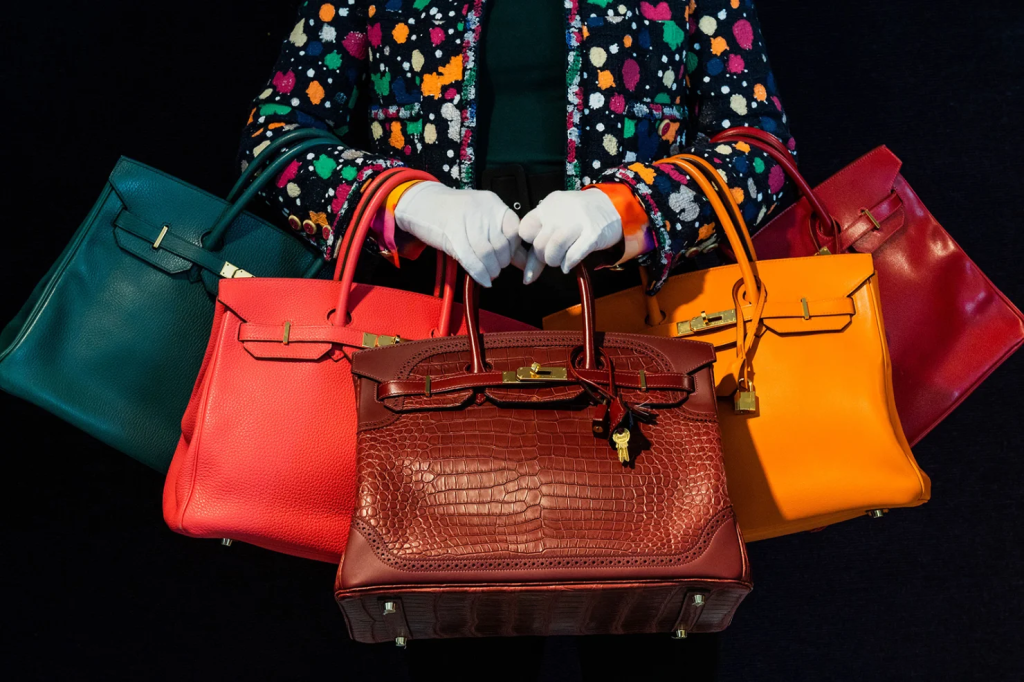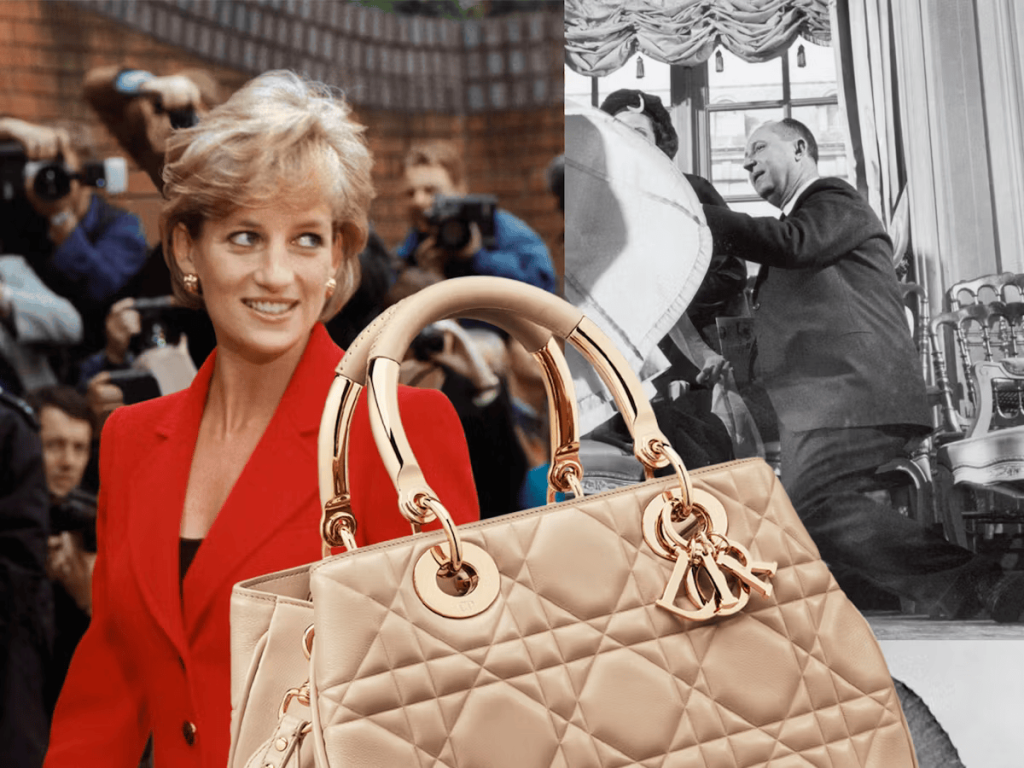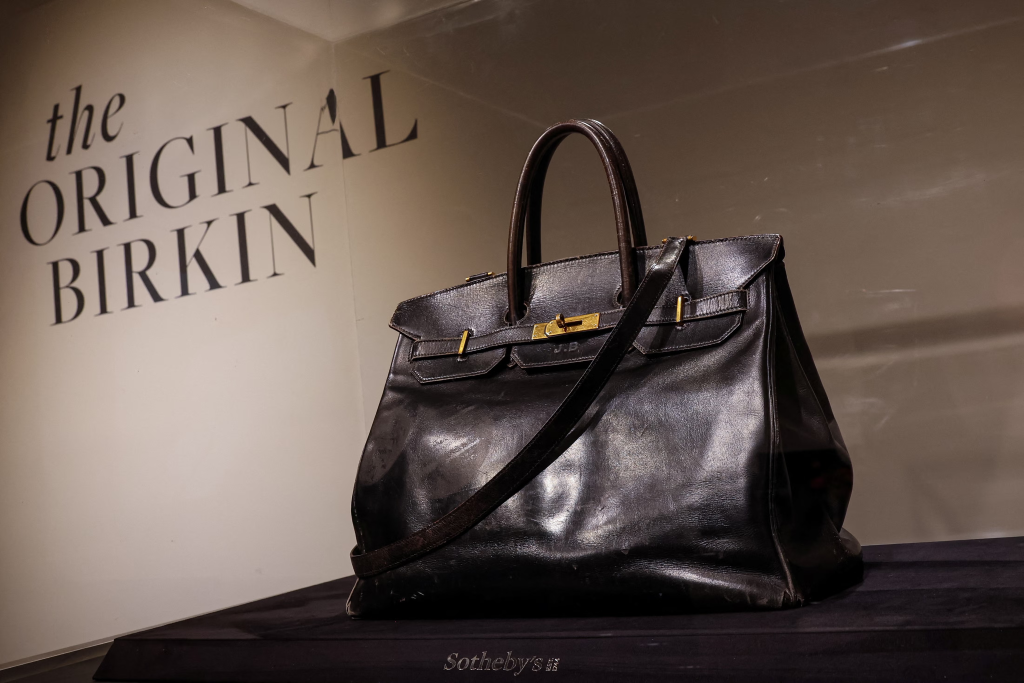Chanel 2.55 bag history begins in February 1955, when Coco Chanel unveiled a shoulder-strapped rebel that freed women’s hands forever. Chanel 2.55 bag history is more than a timeline; it’s a story of wartime ingenuity that evolved into the holy grail of collectors. In this deep dive, you’ll see how every quilted diamond still whispers that original spirit of liberation.
Prologue — Why the 2.55 still matters
Paris, February 1955. Europe is shaking off post-war austerity; jazz pours from basement clubs, television is reshaping leisure, and Dior’s New Look has crowned a new silhouette. Yet women who now drive, work, and travel still juggle a rigid evening clutch designed for a slower century. Into this mismatch steps Gabrielle “Coco” Chanel with a small quilted shoulder bag, the 2.55, whose metal chain frees both hands and signals that elegance can match the speed of modern life.
The bag’s impact is immediate. Magazine covers from Paris to New York hail it as the emblem of a freshly independent archetype—glamorous yet decidedly practical. Away from runways, early adopters like Romy Schneider and Jacqueline Kennedy turned the 2.55 into a status marker that transcends pearls and perfume, fusing craftsmanship with everyday utility — a milestone in the Chanel 2.55 bag history.
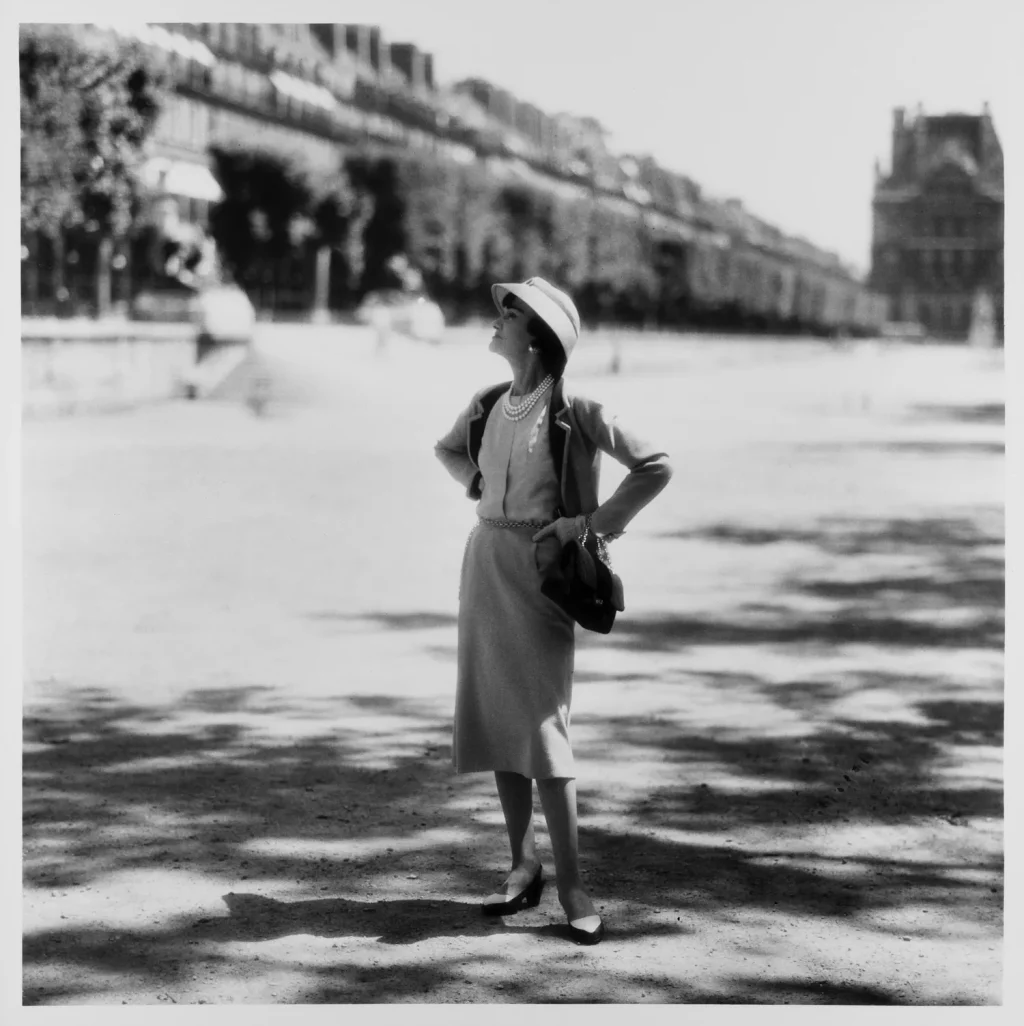
Over seven decades the design has required almost no cosmetic surgery. The burgundy lining still nods to Chanel’s convent childhood, the logo-free Mademoiselle lock still whispers discretion, and the quilting still photographs flawlessly, whether under studio strobes or smartphone flashes. Its price curve now outpaces inflation and even gold; resale platforms treat the bag like a portable blue-chip asset, while sustainability advocates cite its multi-lifetime durability as proof that luxury and circularity can coexist.
This long read traces that extraordinary journey—from the charged atmosphere of mid-century Paris to today’s algorithm-driven fashion economy. We’ll unpack the technical genius of its quilting, decode hidden pockets, chart its price trajectory through booms and recessions, and examine how a leather rectangle became both a feminist milestone and an investment vehicle. Seventy years after its debut, the 2.55 remains astonishingly fresh—an object that reconciles history with modernity and proves that style, when guided by purpose, can outlast every trend it inspires.
Chapter 1 — Chanel 2.55 bag history: the name & the zero hour
In February 1955, Gabrielle “Coco” Chanel opened her rue Cambon apartment to a handful of editors and buyers and unveiled a compact, quilt-stitched shoulder bag. She called it simply “2.55,” anchoring the design to its own birth date—month 2, year ’55—and telegraphing that the object’s story would be inseparable from the modern moment that produced it.
The name served several purposes at once. First, it was a time-stamp marketing device, giving journalists a ready-made headline. Second, the numeric code underscored Chanel’s belief in functional clarity over ornate branding; a handbag meant for speed deserved a label as clean as a departure board. Finally, it marked her triumphant post-war comeback with the confidence of a dateline—an unmistakable “I’m back.”
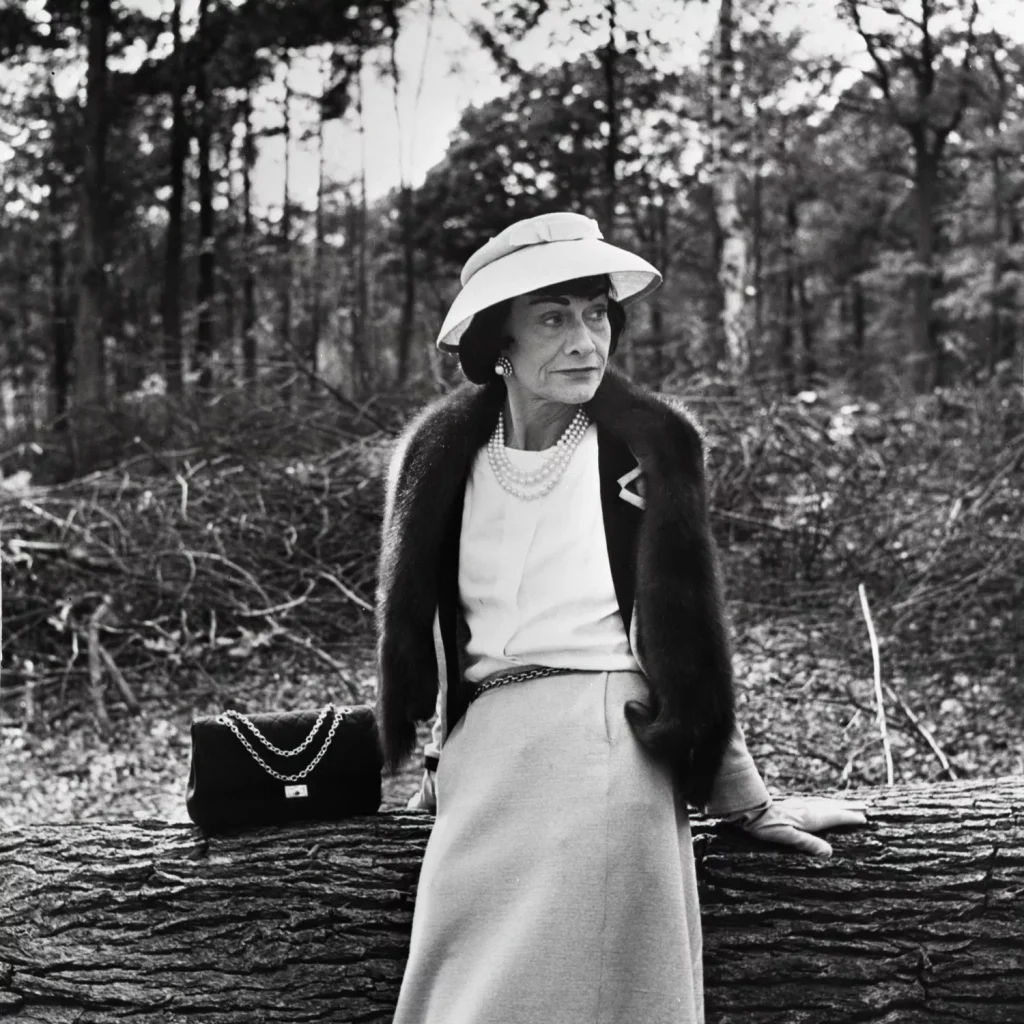
The debut shocked the press. Harper’s Bazaar editor Carmel Snow called the 2.55 “outrageously modern,” praising the shoulder strap that let women keep their hands free. French reporters focused on the radical material choice—supple lambskin, usually reserved for gloves—while buyers quietly registered that the £170 price positioned the bag well above anything comparable on the market. Within weeks leading boutiques in Paris and New York reported waiting lists.
By mid-year the numeric moniker had already become shorthand for a new design attitude: spare, mobile, forward-looking. Mini, Large and Maxi versions soon followed, but the digits never changed; they remained a permanent reminder that great ideas sometimes need only a date and a quiet rectangle of leather to rewrite the rules of fashion.
Chapter 2 — Coco Chanel vs. the conventions of her time
Early-1950s etiquette still dictated that a “proper lady” cradle a petite top-handle bag, one arm bent in permanent courtesy. Chanel saw the absurdity: women were now driving, signing business contracts, boarding overnight trains—yet sacrificing a hand to outdated decorum. Her answer was a polished metal strap, slim enough to read as jewellery but strong enough to shoulder the bag’s weight.
The gesture was more than ergonomic. Draped diagonally, the chain re-positioned the body: shoulders back, hands unoccupied, stride unrestricted. In a single motion the wearer broadcast independence without saying a word. Fashion editors quickly registered a shift from ornamental to operational luxury; a handbag was no longer a prop but a piece of equipment built for urban velocity.
Design cues came from places of unglamorous utility—military satchels with adjustable straps, the key chains jingling at Aubazine’s convent—but Chanel refined them until only the practicality remained visible. Tempered links were welded shut so nothing caught on silk; the drop length was calculated to allow both over-the-coat and cross-body wear; the chain’s cool heft balanced the bag so it wouldn’t pitch forward when lightly packed.
Competitors soon scrambled to copy the idea, yet few captured its psychological impact. Where other evening purses still communicated fragility, the 2.55 projected readiness. In street photography of the late fifties, a woman wearing the quilted rectangle gestures freely, pockets her hands, hails a cab—micro-freedoms impossible with a clutch. The message resonated so profoundly that today every cross-body bag, from festival nylon to couture satin, traces its lineage to that single Chanel innovation.
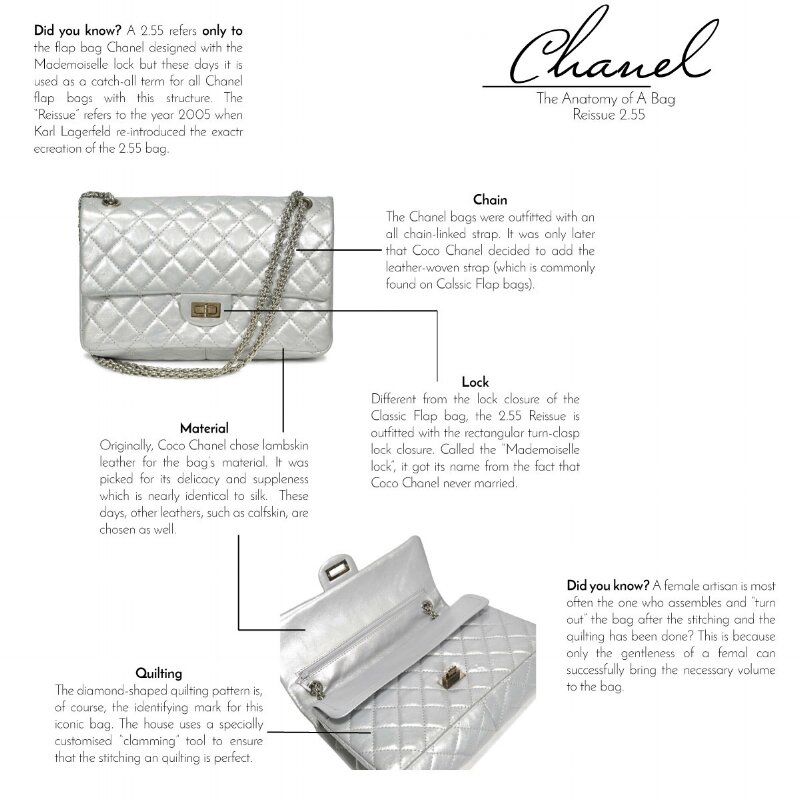
By converting a constraint into an advantage, Coco Chanel rewrote the social script of accessories. She didn’t merely add a strap; she shifted the center of gravity from object to owner, proving that true elegance begins the moment a woman moves through the world unencumbered.
Chapter 3 — The chain: function engine, silent signature
At first glance the 2.55’s chain seems ornamental, yet Chanel treated it as the bag’s drivetrain. She modelled the gauge on two utilitarian references—a soldier’s field strap and the key chains that clinked at the Aubazine convent—then shaved each link until it felt like jewellery rather than hardware. Welds are invisible, seams polished smooth; shake the strap and you hear a muted, confident rattle, proof that it is solid metal, never hollow. Precise weight distribution keeps the bag upright whether it carries a lipstick or a paperback.
Engineering aside, the chain is biography in motion. The martial lineage hints at resilience; the convent memory transforms youthful constraint into adult agency. With every step the links flash a coded reminder that origins, even austere ones, can be repurposed into freedom.
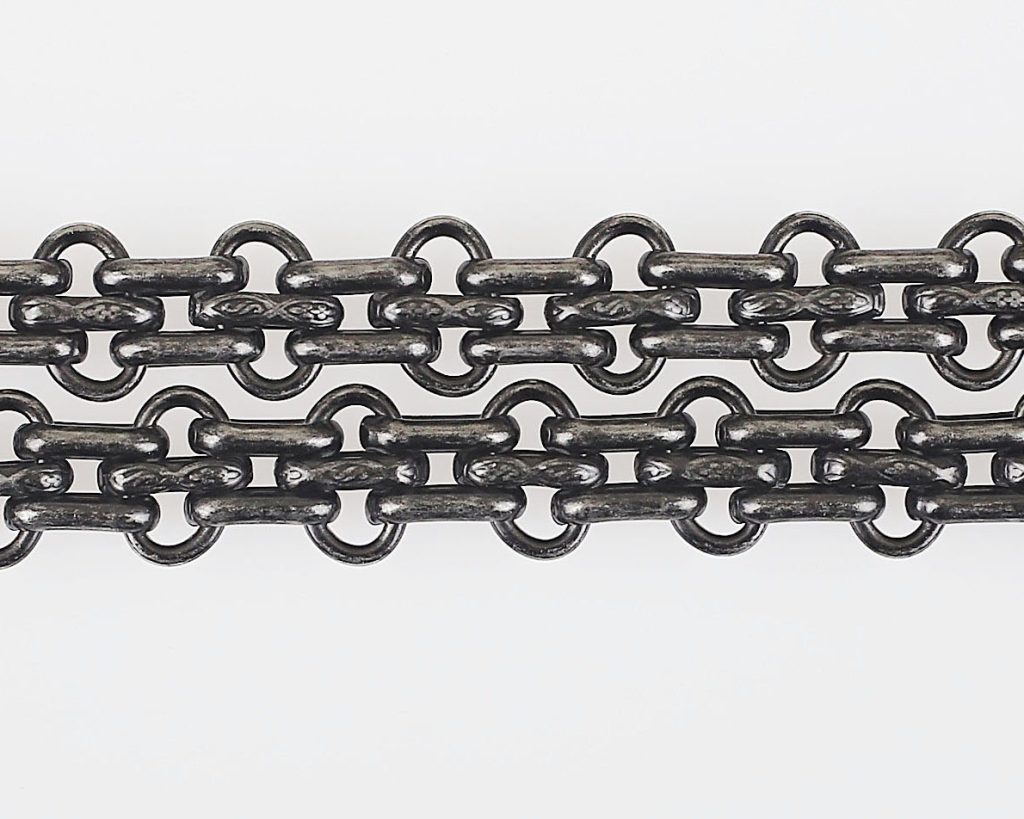
Legacy arrived quickly. Photographers discovered that a diagonal chain carved a dynamic line across the torso, so celebrities wore the bag cross-body long before street-style culture existed. When Karl Lagerfeld relaunched the Classic Flap in 1983 he threaded leather through the same link pattern—a single tweak that softened the silhouette yet preserved the mechanics, underlining how robust the original blueprint was. Today, high-street pouches and tech slings copy the drop length almost to the millimetre, unaware that they’re quoting a 1955 prototype.
Crucially, the chain has outlived every trend unaltered. It needs no monogram to declare its provenance; seasoned eyes recognise the cool glint, the perfect drape, the way it balances a quilted rectangle as naturally as a shoulder socket. In the ecosystem of the 2.55, that strip of tempered metal is both backbone and signature, ensuring the bag moves through each decade with the same effortless authority it claimed on day one—a living chain that still narrates the Chanel 2.55 bag history every time it swings.
Chapter 4 — The “Mademoiselle” lock: quiet power in a quarter-turn
Where most luxury houses shouted identity with ornate clasps, Chanel chose a slim, rectangular turn-lock that says almost nothing—until you listen closely. She called it the Mademoiselle lock, a nod to her lifelong unmarried status, but the real statement lies in what it omits: no initials, no crest, just two polished bars that rotate ninety degrees with a whisper-click. That minimalism amplifies the bag’s architecture; the lock behaves like punctuation, anchoring the quilted geometry without distracting from it, while quietly honoring the Chanel 2.55 bag history.
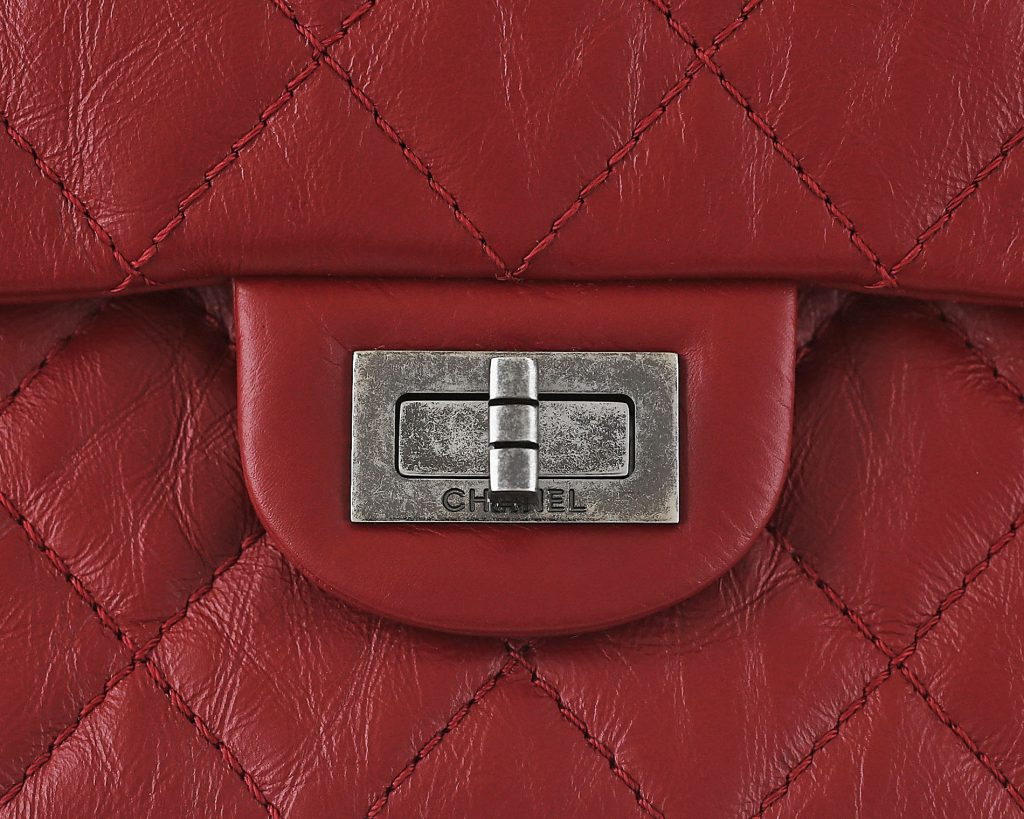
The engineering is as meticulous as the symbolism. Each brass plate is laser-cut to micron tolerances, then riveted through the leather so no screws disturb the garnet lining. A tiny leaf spring hidden behind the face controls resistance: too loose and it spins in transit, too tight and it scars the plate. Artisans test every clasp by feel, snapping it shut with gloved fingers to ensure the motion is silent yet decisive—luxury registered through touch, not volume.
In 1983 Karl Lagerfeld introduced the interlocking CC lock on the new Classic Flap, satisfying an era hungry for visible branding. Yet he never abandoned the original mechanism; the twin Cs simply mask the same quarter-turn cam. The coexistence of both clasps tells a larger Chanel truth: innovation can add exclamation points without erasing earlier sentences. Today collectors parse the locks the way watch fans study calibres: Mademoiselle for stealth, CC for theatre.
Ultimately, the lock completes the 2.55’s promise of liberated movement. One flick secures the flap, leaving the wearer free to hail a cab or raise a champagne glass—no fidgeting, no fuss. In that small, almost private gesture, the bag reinforces Coco’s central thesis: elegance should serve the life you lead, not the other way around.
Chapter 5 — The diamond quilt: form, memory, engineering
At first glance the 2.55’s surface is a simple grid of padded lozenges; in practice it is the bag’s hidden framework. Quilting stiffens pliant lambskin without resorting to cardboard inserts, letting the shell stand upright yet flex with use. Chanel’s artisans achieve this by layering leather, a whisper-thin cotton batting, and a backing canvas, then sewing them together along perfectly chalked diagonals. Eleven stitches march down each side of every diamond—one or two fewer and the pattern balloons, one or two more and the leather puckers. The result is a self-supporting textile that keeps its silhouette even when the bag is empty, a silent triumph in the Chanel 2.55 bag history.
The motif also stores fragments of Chanel’s visual life: equestrian jackets, the gridded blankets thrown over thoroughbreds, and the lead-lined panes of Aubazine’s chapel windows. Those references converge in a pattern that catches light like a prism, scattering highlights across each raised facet. Black lambskin reads almost liquid under gallery spots; aged calfskin, with its fine creases, absorbs daylight and returns a muted glow. That play of light—not logos—makes the 2.55 instantly recognisable across a room.
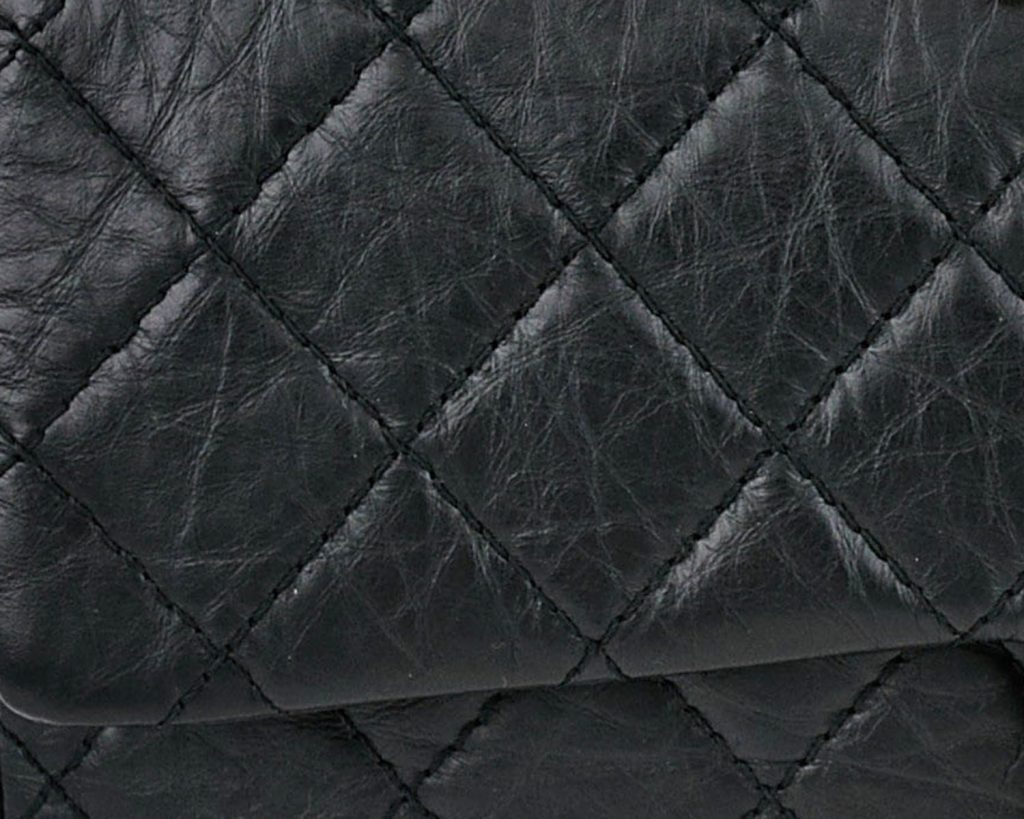
Crafting the quilt is partly an acoustic exercise: seasoned machinists listen for the needle’s pitch. A change in tone means the batting has slipped or tension has drifted, and they halt the machine mid-stitch to correct it. Finished panels are chilled briefly to set the puff, then warmed by hand so the leather relaxes before assembly, ensuring the diamonds neither deflate nor stiffen with age.
Function follows aesthetics. The grid spreads pressure from interior objects, preventing lipstick tubes from printing circles on the exterior. It also discourages cracks along the flap bend—each stitch line acts like a tiny expansion joint. Over decades the diamonds soften but never disappear, recording gentle wear like topographic rings on a well-loved map.
In short, Chanel’s quilting is more than decoration; it is architecture in miniature—a structural solution rendered so beautifully that most owners experience it as pure ornament. That convergence of purpose and poetry is precisely why the pattern, untouched since 1955, still feels inevitable today — a testament to the enduring Chanel 2.55 bag history.
Chapter 6 — Material evolution: from jersey to aged calfskin
At launch, Chanel cut the 2.55 from navy jersey—the same soft wool she once borrowed for her first cardigans. The choice answered two practical needs of post-war Paris: fabric rationing and weight. Jersey kept the bag feather-light, a persuasive argument for a shoulder style still viewed with suspicion by clutch-clinging society — early proof that the Chanel 2.55 bag history was rooted in pragmatism.
Lambskin entered the picture only a few seasons later, bringing a refined grain and a subtle sheen that jersey lacked. Pliant enough to quilt yet strong enough to take daily use, it quickly became the reference material for the 2.55. Through the 1960s and ’70s Chanel expanded the lambskin palette from strict black to creams, reds and the now-classic “beige Claire,” matching the era’s growing appetite for colour without altering construction.
A different leather assumed the workhorse role in 1986, when Karl Lagerfeld introduced pebbled caviar calfskin. Its tumbled surface resisted scratches and rain, answering the practical demands of a busier, more urban clientele. By the late 1990s caviar accounted for a significant share of sales, establishing a durable alternative for those unwilling to baby their bag.
For the 50-year anniversary in 2005, Lagerfeld unveiled an aged calfskin Reissue. Pre-wrinkled and matte, the hide looked like it had already lived through decades of soirées and taxi rides, giving buyers an instant patina without the anxiety of first scuffs. The finish became a signature of the Reissue line, prized for its low-maintenance character and vintage mood.
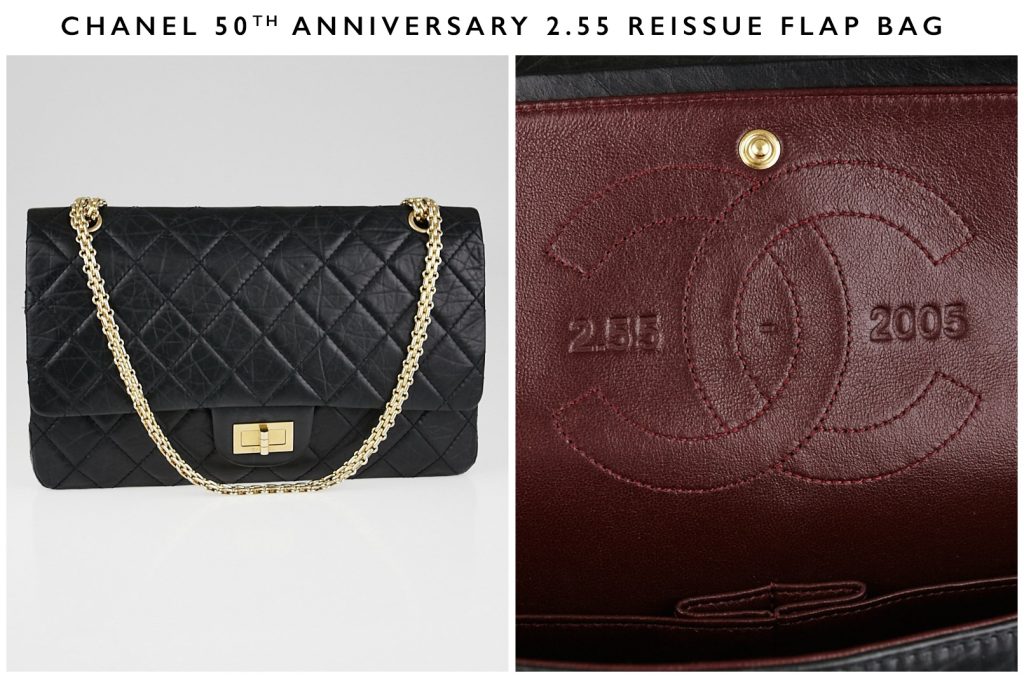
Materials continued to diversify: distressed denim for cruise collections; pearlised patent lamb for nightlife sparkle; straw and raffia for summer capsules; and, before the brand’s 2018 ban on exotics, limited runs in alligator, python and lizard. Seasonal experiments rarely last more than a runway cycle, yet they all funnel through the same template, proving that the 2.55 can absorb almost any texture without losing its silhouette.
Today, Chanel pairs its heritage palette with modern sustainability goals. Recycled-wool jersey has re-emerged in eco-capsules, and vegetable-tanned calfskin offers a chromium-free option that still meets the maison’s strict softness standard. Whatever the skin or fabric, each panel must pass the same test: when quilted it must puff just enough to hold shape, flex enough to fold, and age in a way that tells a wearer’s story rather than obscuring it.
Chapter 7 — The interior: discreet engineering, personal theatre
Lift the flap of a 2.55 and light hits a burgundy calfskin stage—deep enough to spotlight every object, dark enough to hide wear. Chanel chose the hue for contrast, but its real brilliance is psychological: the moment you open the bag, even lipstick becomes a prop in an intimate play.
Function drives the layout. A slim, full-width sleeve sits just behind the flap for train tickets or folded letters. Directly above, an almost invisible zip pocket hides beneath the upper seam; pull the slider and you find a slot barely thick enough for a note, too small for a phone—privacy by design, not by lock. Two gusseted pouches on the back wall hold a compact and card case without bulging the exterior quilt, while a stitched tunnel near the side seam cradles a lipstick so snugly it won’t rattle in a taxi.
Every panel is horsehair-backed so the compartments spring open and snap shut without sagging. Edges are skived to half a millimetre, then double-folded and stitched with the same silk thread used on the exterior diamonds, ensuring the inside ages at the same pace as the shell.
The cumulative effect is choreography. You reach for a card, the sleeve delivers it; you unzip the hidden pocket, a note slides out like a secret; you cap your lipstick, the holster guides it home. Nothing jostles, nothing imprints on the leather. In a world of cavernous totes, this disciplined interior reminds you that luxury is not abundance of space but precision of space—every centimetre accounted for, every gesture considered.
Chapter 8 — The back-panel “smile”: utility with a wink
Turn the 2.55 over and you meet a gentle crescent carved into the quilted leather—a pocket so flush to the surface it appears only when light grazes the curve. This design does three jobs at once and anchors another page in the Chanel 2.55 bag history.
Fast access. Placed exactly at palm height, the slot lets you slip in a metro pass, valet ticket, or folded bill without lifting the flap. You feel the opening by touch, pull, and pay—no rummaging, no display of contents.
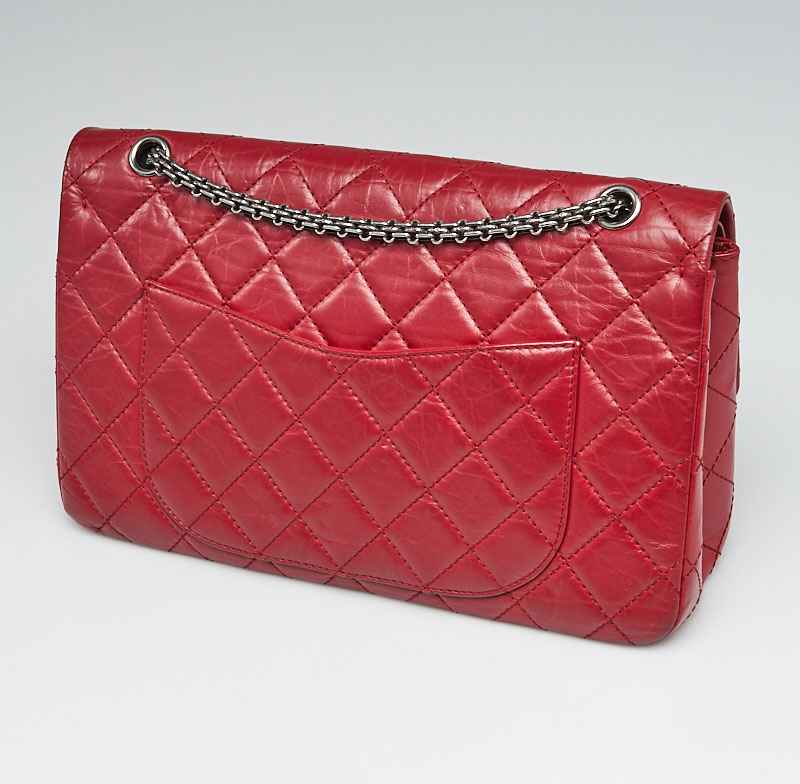
Structural balance. The crescent seam reinforces the rear panel, preventing the quilt from stretching where the bag rubs against the body. Because the pocket is cut from the same single hide, the diamond grid remains uninterrupted and the silhouette stays crisp over years of wear.
Quiet personality. Chanel’s ateliers call it the poche sourire—the smiling pocket—because the curve echoes the up-turned mouth of someone receiving a discreet tip. The reference is subtle; most onlookers miss it, yet owners know it’s there, adding a private note of charm to an otherwise disciplined façade.
No logos, no extra hardware, just a hidden grin that fuses practicality with character—the very formula that keeps the 2.55 modern.
Chapter 9 — Size & variant guide: mini to maxi, code to lifestyle
Chanel organises the Reissue 2.55 line around four core lengths, each defined by its original production code—224, 225, 226, 227—numbers that once roughly matched centimetres across the base. The codes survive on modern care cards and metal plaques, so recognising them is the quickest route to the right fit.
224 Mini (≈ 20 cm) is an exercise in essentials: phone, card holder, key fob, lipstick. Doubled high on the ribcage it behaves like jewellery, perfect for gallery evenings or weddings where a clutch feels dated. Its smaller footprint means lighter chain swing and virtually no risk of corner wear.
225 Original (≈ 24 cm) traces closest to Coco’s prototype and excels as an everyday carry. It slips under a blazer without bulging, yet holds a continental wallet plus sunglasses. Commuters favour it because the bag perches flat against the torso, leaving hands free for coffee and train straps.
226 Large (≈ 28 cm) appeals to professionals who juggle devices. An A5 notebook, slim e-reader, and charger brick nest comfortably without distorting the quilt. The slightly longer drop lets the bag ride lower on thicker outerwear—handy in colder climates.
227 Maxi (≈ 31 cm) edges toward tote territory, cradling a tablet or lightweight cardigan for flights and day-trip agendas. Worn cross-body it anchors at the lumbar curve, distributing weight across the shoulder and making room for airport duty-free without adding another bag.
Because each piece is hand-cut and quilted, a tolerance of three to four millimetres is normal; Chanel’s inspectors judge alignment, not a micrometer reading. Interior architecture—burgundy lining, ticket sleeve, lipstick sheath—remains identical across the range, ensuring you sacrifice only bulk, never functionality, when stepping down in size.
Choosing among them is less about height and more about daily cadence: cocktail-hour minimalism, metro-ready versatility, client-meeting capacity, or weekender range. Once that rhythm is clear, the code—224, 225, 226, or 227—does the rest, delivering the same diamond-quilted grammar in a dialect scaled precisely to your life, echoing the original Chanel 2.55 bag history.
Chapter 10 — Lagerfeld’s pivot: from 2.55 to Classic Flap
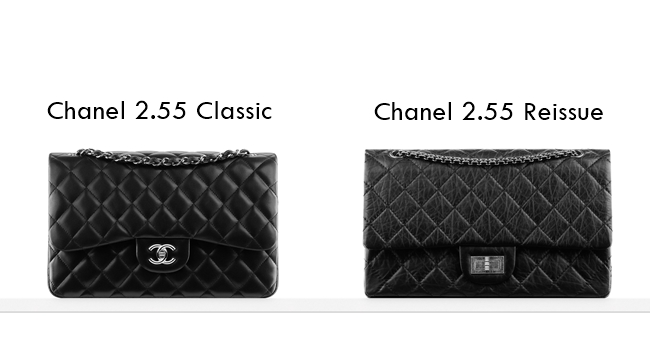
When Karl Lagerfeld arrived in 1983, Chanel’s archives were revered but risked looking archival. His solution was surgical: preserve the 2.55’s structure, replace its quiet clasp with a gleaming double-C turn-lock, and thread a ribbon of matching leather through the chain. Those two tweaks—logo forward, touch softened—created the Classic Flap (style code 11.12) and telegraphed a bolder mood suited to shoulder-padded power suits and flashing street photography.
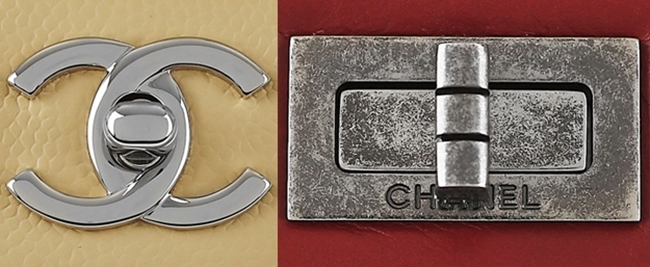
Nothing else changed. Diamond quilting, burgundy lining, hidden zip pocket, and diamond-matched seams all survived intact, proving the chassis was future-proof. The double flap Lagerfeld added under the exterior front panel stiffened the bag, protecting its boxy silhouette against heavier 1980s cargo—brick-size car keys, first-generation cell phones—while sacrificing only a sliver of capacity.
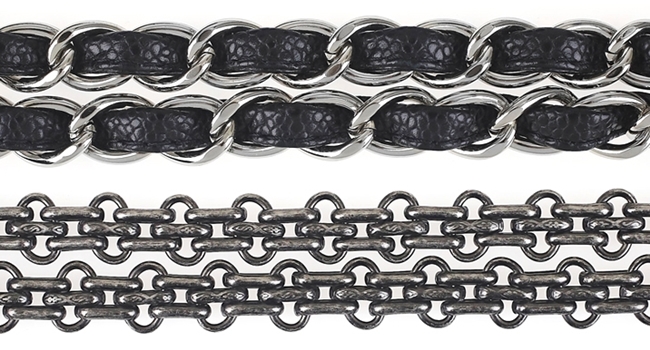
Market reception was immediate: visible branding satisfied an era newly fluent in status symbols, and wait-lists formed faster than production could scale. The Classic Flap’s global success funded Chanel’s acquisition of specialist Métiers d’Art workshops, ensuring that every logo clasp still rests on hand-stitched quilting. Collectors now view the Classic and Reissue as twin pillars rather than rivals: one speaks Lagerfeld’s extroverted glamour, the other Coco’s minimalist resolve. Together they show how a single silhouette can navigate decades simply by changing the accent on its hardware.
Chapter 11 — The 2005 Reissue and the art of updating an icon
On the bag’s fiftieth birthday, Karl Lagerfeld staged a rare act of reverse-innovation: he put the Classic Flap’s high-voltage CC logo back in the drawer and re-issued the 2.55 exactly as Coco had shown it—bare metal chain, slim Mademoiselle lock, aged calfskin that looked already lived-in. The label on the showroom cards read simply “2.55 Reissue 2005.” Collectors instantly understood the double meaning: a tribute to the original and a reminder that authenticity itself can be a form of novelty.
Demand outran supply, and a micro-taxonomy was born. That collector frenzy became a textbook case in the Chanel 2.55 bag history, proving authenticity can be a novelty.
Bags from that first anniversary run—most stamped with series code A37586—now trade at a premium because they were the only ones to carry both the “Reissue” tag and the exact 2005 date card. All later builds kept the specifications but dropped the anniversary wording, morphing into the standard “Reissue 2.55.” In resale listings that single line on the card can swing prices by thousands.
Rather than freeze the model in museum glass, Chanel has used the Reissue as a canvas for controlled experimentation. Cruise 2008 delivered quilted dark denim trimmed in chalk-white chain; Paris–Shanghai 2010 swapped metal links for glossy red enamel; the “So Black” edition (Métiers d’Art 2011) drowned both chain and lock in jet hardware, turning minimalism into stealth chic. Tweed, raffia, holographic goatskin, and—before the brand exited exotics—smoky grey python have all cycled through limited runs without altering dimensions or pocket layout. The silhouette stays constant; the surface tells the season’s story.
Two converging markets make these variations more than fashion curiosities. On the primary side, boutique scarcity encourages clients to accept adventurous leathers simply to secure a Reissue slot. On the secondary side, rarity plus intact heritage engineering keeps value buoyant: a denim Reissue released at $5,600 in 2008 now resells north of $9,000 if the chain enamel remains pristine.
What ties the timeline together is a design equilibrium. Chanel re-spins colour, texture, and hardware finishes, yet never touches the structural DNA: quilt grid, interior burgundy, hidden zip. Each reinterpretation therefore acts like a limited print of a classic photograph—new palette, same negative—ensuring the bag evolves without drifting from its origin point. In an industry that often confuses novelty with obsolescence, the Reissue proves a luxury icon can renew itself simply by changing the fabric of its story, not the shape of its frame.
Chapter 12 — 2.55 vs Classic Flap: two voices, one DNA
The comparison below shows how two voices spring from one DNA rooted in the Chanel 2.55 bag history.
| Core Detail | 2.55 (Reissue) | Classic Flap (11.12) |
| Front lock | Slim, logo-free Mademoiselle turn-lock | Interlocking CC turn-lock |
| Chain | Bare metal links, longer drop; ideal cross-body | Metal links woven with leather; sits higher on shoulder |
| Construction | Single flap; seven-pocket burgundy interior (lipstick slot, zip sleeve) | Double flap adds rigidity; inner map pocket, no lipstick slot |
| Weight / Look | Lighter, flatter profile; reads archival, understated | Slightly heavier, boxier; projects brand presence |
| 2025 medium price | ≈ $10.4 k | ≈ $11.7 k |
How they feel in real life
The Reissue whispers history: chain glides cool against fabric, lock twists silently, profile tucks neatly under a trench. Reach for it if you prize stealth wealth, vintage mood, or hands-free length.
The Classic Flap speaks in flashes: CC clasp catches light, leather-laced chain cushions shoulder pads, double flap guards structure when you pack phone chargers and sunglasses. Choose it when instant brand recognition or extra stiffness matters.
Both outpace inflation and ride every price increase, but resale data suggests different temperaments: Reissue values rise steadily with age, while seasonal Classic Flaps spike faster—then level—depending on colour or hardware rarity. Whichever clasp clicks for you, the underlying chassis is the same; the decision is simply how loudly you want the bag to announce itself.
Chapter 13 — Métiers d’art craft: how Verneuil-en-Halatte builds a 2.55
Just north of Paris, the glass-roofed atelier at Verneuil-en-Halatte is where raw hides become diamond-quilted architecture. A single medium Reissue spends about twenty working hours here, advancing through three broad stations—cutting, quilting, assembly—each staffed by artisans whose training rivals haute-horlogerie.
Cutting: the one-millimetre rule
Only full-grain lambskins that pass daylight inspection reach the cutting table. Panels are chilled briefly to firm the fibres, then die-cut so the quilt grid will align perfectly across future seams. A tolerance tighter than one millimetre is enforced; any broader variance would distort the diamonds at the side gussets.
Quilting: stitching air into structure
Leather, cotton batting, and canvas backing are layered and guided under a pneumatically balanced needle set to exactly eleven stitches per diamond side—the sweet-spot that inflates loft without puckering. Quilters listen for the thrum of the machine; a change in pitch signals drifting tension and triggers an immediate stop-and-reset.
Assembly: three-dimensional origami
Quilted rectangles are folded and stitched, then turned right-side-out through an opening no wider than a shirt cuff. The burgundy lining, complete with ticket sleeve and lipstick tunnel, is inserted next. Each Mademoiselle lock is placed using a brass jig that guarantees dead-centre alignment, while chain anchors are riveted through hidden leather tabs to prevent stress on the flap.
Quality walk
Before packing, three inspectors—none of whom touched the bag earlier—take it on a slow circuit under shifting skylight, checking colour uniformity, quilt symmetry, and the silent quarter-turn of the lock. Only after this “promenade” is the chain wrapped in rice paper and the bag slipped into a linen dust cover.
Every stitch, fold, and rivet therefore carries the imprint of dozens of human decisions—proof that even in a digitised age, the 2.55 remains a product of hand, eye, and the quiet dialogue between them.
Chapter 14 — The price curve: From £170 to five digits
Each price point that follows charts another chapter in the Chanel 2.55 bag history, showing how cultural demand converts quilting into capital.
1955 – £170. The inaugural 2.55 costs about $220—already the priciest shoulder bag in Paris.
Early 1980s – ≈ $1,000. Inflation and growing demand quadruple the ticket before Lagerfeld arrives.
2010 – $2,850. Chanel’s first big, globalised price hike signals that the bag is now treated as an asset, not just an accessory.
2016 – $4,900. Annual increases become a ritual; waiting lists lengthen.
2025 – ≈ $11,700 (Classic) / $10,400 (Reissue). Harmonised global pricing and limited production push the medium size past five digits.
Compound effect. Averaged over seventy years, the 2.55’s price grows about 5.8 percent annually—slower than the S&P 500 but achieved with a physical object you can carry to dinner. Boutique sell-outs keep resale values within striking distance of retail; limited-run colours and first-edition Reissues often trade above it.
Why the climb continues
- Managed scarcity. Verneuil-en-Halatte can only scale so far without sacrificing handcraft, keeping supply tight.
- Cost realignment. Chanel absorbs Métiers d’Art workshops; higher artisan wages, stricter tanning rules, and EU sustainability standards raise base costs.
- Price harmonisation. Since 2019, Chanel adjusts worldwide tags to the euro, eliminating currency arbitrage and locking in upward moves everywhere at once.
- Veblen demand loop. Rising prices feed desirability, which justifies the next increase—textbook luxury economics.
The takeaway: a 2.55 is not a get-rich-quick instrument, but for owners willing to enjoy their capital in quilted form, history suggests the bag will keep pace with—and sometimes outrun—traditional hedges, all while aging into an heirloom rather than a line on a brokerage statement.
Chapter 15 — Pre-loved power: resale, sustainability, digital curators
The moment a 2.55 leaves the boutique it enters a second economy where prices seldom dip far below retail. Resale sites report sell-through rates above 85 percent for well-kept Reissues; black lambskin with gold hardware often lists at 90–100 percent of current boutique tags, while rare seasonal colours or 2005 “true Reissue” pieces eclipse them. Because Chanel raises retail annually, a bag bought two years ago can resell today for what you paid—or more—after fees.
That liquidity now intersects with a cultural pivot toward circular fashion. Buying pre-loved diverts fresh leather production, a point platforms trumpet with “carbon saved” badges. Vestiaire Collective calculates that re-circulating a single medium Reissue avoids roughly 17 kg of CO₂—the emissions of a Paris-to-London train trip—while preserving all the workmanship embedded at Verneuil-en-Halatte.
Digital infrastructure has professionalised what was once peer-to-peer swapping:
- Authentication labs. Vestiaire, The RealReal and Rebag employ ex-atelier artisans who inspect quilting tension, hologram fonts and micro-engraved lock plates under microscopes. Certain 2021-onward stickers even embed NFC chips readable by proprietary scanners.
- Instant quotes. Rebag’s Clair AI pulls thousands of data points to present a buy-out price in seconds, turning handbags into near-cash assets.
- Provenance passports. Blockchain start-ups pilot digital certificates that travel with the bag, recording every repair or ownership change—vital for investment-grade pieces.
Scarcity and sustainability form a reinforcing loop: limited boutique supply pushes newcomers to resale; each second-hand purchase validates the bag’s durability, attracting more eco-minded buyers. The result is a virtuous marketplace where a 2.55 can change hands multiple times, accrue patina, and still command respect—and capital—far into the future, exactly as the Chanel 2.55 bag history predicts.
Chapter 16 — Pop-culture co-stars: the 2.55 on famous shoulders
From Jacqueline Kennedy’s White House wardrobe to Janelle Monáe’s gender-fluid tuxedos, the 2.55 has adapted to every style script without altering its lines.
1960s – 1970s: Political polish and jet-set ease
Jackie paired a quilted black Reissue with pastel suits, proving a shoulder bag could look presidential. In Europe, Romy Schneider and Jeanne Moreau wore the same model cross-body, turning it into shorthand for modern womanhood on café terraces and cinema posters.
1980s – 1990s: Rock grit meets runway glam
Princess Diana swung a navy 2.55 over bike shorts after gym sessions—an early athleisure image that still trends on Pinterest. Kate Moss cemented the bag’s grunge credentials in off-duty photos: leopard coat, cigarette, well-worn Reissue slung low like contraband.
2000s: Red-carpet reboot
Karl Lagerfeld cast the Classic Flap in campaigns, but actresses such as Penélope Cruz often reverted to the logo-free Reissue for premieres, letting matte aged calfskin tone down crystal gowns. The contrast reminded audiences that understatement can upstage sparkle.
2010s – Today: Social-media multiplicity
Janelle Monáe doubles the chain high on the waist or lets it fall hip-length, styling a graphite Reissue with Harlequin couture one night and streetwear the next. On TikTok, creators hashtag #ChanelChainChallenge, looping vintage Reissues around oversized blazers as a nod to gender-neutral styling.
Why the cameo keeps working
The 2.55’s lack of overt branding lets each wearer project her own narrative—political grace, rebel edge, or fluid futurism—while its quilted geometry ensures instant recognition to the informed eye. In photos shot sixty years apart, the constant is the bag’s quiet authority; everything else is the era talking.
Chapter 17 — Quick-scan authentication: reading a 2.55 like a passport
Serial & Sticker
Start inside: every bag from late-1984 onward carries a laminated hologram with a two-digit “series” prefix that dates the piece (40 = 2023, 41 = 2025, etc.). Digits are laser-clean, sit under a clear film shot through with microscopic double-C watermarks; ink bleed or fuzzy edges flag trouble. A matching plastic card is nice but not decisive—the sticker rules.
Lock Plate & Screws
Flip the flap. A genuine Mademoiselle plate is held by two perfectly vertical flat-slot screws; cross-heads or slanted slots mean walk away. Micro-engraving reads “CHANEL PARIS” with open, round counters—no crushed “O” or crooked accent on É.
Quilt Alignment & Stitch Count
Eleven even stitches per diamond side keep the grid taut; fewer stitches create pillows, more cause ripples. Diamonds must match at every seam—check where the side gusset meets the base. Mis-matched points betray factory shortcuts.
Chain Test
Bare-metal Reissue chains feel heavy (≈ 120 g on a medium) and cold. Links are welded closed, so a fingernail glides without snagging. Shake it: real chains emit a soft, dense clink, never a tinny rattle. A small magnet should barely cling—high-grade alloy, low iron.
Leather & Smell
Lambskin is satin-smooth and warms quickly to the hand. Aged calf has a dry, waxy feel. Any plastic odour or chemical sweetness signals synthetic finishes used in counterfeits. Lightly flex a corner; authentic skins produce fine, shallow lines, not deep creases.
One-Minute Kit
Pocket loupe (10×), mini LED torch, millimetre tape, and a smartphone app for series lookup. Photograph the sticker under flash, then daylight; hologram shifts colour under angle. If possible, scan NFC on 2021-onward tags—Chanel embeds a hidden chip.
Master this five-point pass and you can sort genuine from fake in under a minute, saving deeper forensics for only the bags that earn it, a shortcut distilled from decades of Chanel 2.55 bag history.
Chapter 18 — Care, storage & the quiet power of a bag pillow
A 2.55 will age with grace only if its keeper respects three variables: surface, climate, and shape.
Daily discipline
Set the bag on clean, dry tables—no marble edges or café crumbs. Dust city grit with a soft microfibre cloth before the leather cools; this prevents grime from settling into the grain. Empty every pocket each night so keys or lipsticks don’t emboss the lining.
Climate control
Lambskin dislikes extremes. Aim for a wardrobe zone around 50 % humidity and 15–20 °C. Direct sun fades dye; overheated closets draw natural oils to the surface, creating the dreaded sticky gloss. Wrap the chain in a soft pouch, then rest the bag inside its breathable cotton dust sleeve—never plastic, which traps moisture.
Shape insurance
Stuffing with tissue collapses over time and can leach ink. A purpose-cut insert—such as a LA FORMA I Bag Pillows—fills every corner with gentle, even pressure. Its cotton-linen shell wicks residual humidity, while a hypoallergenic microfibre core prevents the quilt from caving during long rests. Insert first, coil chain inside, lay the bag flat; gravity then distributes stress across the pillow, not the gusset fold.
Seasonal conditioning
Twice a year, massage a pearl-sized dab of neutral, wax-free balm into lambskin using circular strokes. Aged calf benefits from a slightly richer formula; caviar needs only a dry wipe. Avoid the burgundy lining—calf interior already holds a protective finish. Let the bag air open overnight so volatiles dissipate, then re-pillow and shelve.
Follow these habits—clean surface, stable climate, shaped support—and the 2.55 will reward you with supple leather, sharp diamonds, and a silhouette ready for its next chapter of use, whether that’s tomorrow’s commute or a grand-daughter’s first soirée.
Chapter 19 — Styling science: from denim to haute couture
Casual city denim
Pair a distressed-denim jacket, high-rise straight jeans and white sneakers with a matte aged-calf 225 Reissue worn full-length. The quilted black rectangle breaks up the indigo, while the metallic strap adds just enough polish for errand hopping or a terrace espresso. Swap to a 224 Mini in pearlised patent for sunset drinks—double the chain so the bag rides just under the ribcage and functions like jewellery.
Office pragmatism
Quiet-luxury tailoring loves caviar leather. A 225 Classic Flap in beige Clair balances an oversized charcoal blazer and pleated trousers. Slip the chain inside and carry it briefcase-style into meetings; shoulder it cross-body for the commute home. Burgundy lining provides the only pop of colour when you reach for business cards, keeping the palette boardroom neutral.
Black-tie codes
For gowns with sparkle, choose understatement: a satin-quilted 224 or a “So Black” Reissue on a single drop. Shorten the chain by tucking half inside the flap; the bag hovers at waist height, leaving hands free for champagne and introductions. If the dress is minimalist, invert the equation—opt for iridescent goatskin or micro-sequin tweed and let the bag supply the shimmer.
Festival & streetwear
Denim 227 Reissue + cargo shorts + retro trainers = posh utility. Wear the strap bandolier-style so the bag anchors at the lower back, freeing the front torso for dance moves. Inside, a ticket sleeve keeps wristbands flat, and the back “smile” pocket stashes cash for quick merch buys.
Gender-fluid styling
Oversized poplin shirt, tailored shorts, chunky boots and a graphite 226 slung cross-torso. The bag’s strict geometry offsets relaxed silhouettes, and the neutral gunmetal hardware skirts gendered tropes—proof a classic can live comfortably in a non-binary wardrobe.
Trend overlays
Quick strap math
Single-length for casual drape, doubled for cocktail, tucked-in for clutch mode. One bag, three personas, no extra hardware required.
- Loud-luxury neon: ground it with an ivory lambskin Reissue—brightness framed, not overwhelmed.
- Earth-tone minimalism: introduce a bronze caviar 225; metallic warmth boosts otherwise muted layers.
- Y2K revival: loop a holographic 224 twice and wear it belt-bag style over a low-slung skirt—nostalgia without kitsch.
The takeaway: treat the 2.55 not as a fixed accessory but as a modular accent. Adjust chain, finish and placement, and it will slip seamlessly from denim mornings to couture midnights—always adding authority, never stealing the scene.
Epilogue — A quilted blueprint for the future
Across decades of fashion change, the Chanel 2.55 bag history keeps proving one idea: utility ages best. In every decade since 1955, the bag has absorbed cultural change—political elegance with Jackie Kennedy, rock-and-roll grit with Kate Moss, gender-fluid cool with Janelle Monáe—without surrendering its original brief: free a woman’s hands and treat practicality as the highest form of luxury.
That consistency explains its unusual trajectory. Price charts show steady compound growth; resale platforms treat it like a circulating bond; sustainability campaigns hold it up as proof that craftsmanship can outlast carbon curves. Behind each metric lies the same engineering logic: eleven stitches per diamond, a chain tuned to balance, a lock that whispers rather than shouts.
Looking ahead, the forces shaping fashion—AI-driven trend cycles, climate mandates, fluid identities—only strengthen the bag’s relevance. A design built on utility can always translate new aesthetics; a silhouette free of overt logos sidesteps fad fatigue; a construction made to survive decades naturally slots into circular commerce, just as the Chanel 2.55 bag history keeps demonstrating.
Carry a 2.55 and you inherit more than a heritage object; you join an experiment in durable freedom. Every scratch and softening edge will be your own chapter added to Coco’s original plot. And when you pass it on—tomorrow or fifty years from now—it will still open with a turn of that discreet lock, ready for the next pair of hands to write the next story in quilted shorthand.
